#if i were in the league and witnessed these double standards i would be throwing hands with this little emo bitch lmao
Explore tagged Tumblr posts
Text
no matter which way you look at Shigadabi's relationship, it's undeniable that Dabi is Shigaraki's special boy and it makes the LOV's dynamic additionally hilarious.
*almost kills Toga just because she was standing next to Dabi when he was being a little bitch* 'everyone I've decided to put this guy in charge'
yes I will rent you out to the yakuza without asking for your consent or giving any proper explanation. yes Dabi is free to come and go as he pleases. yes, he is our only long range fighter why do you ask. this is all a part of my plan to tame him actually. have you ever heard of catboys btw
#if i were in the league and witnessed these double standards i would be throwing hands with this little emo bitch lmao#bnha#shigadabi#dabi#shigaraki
286 notes
·
View notes
Text
The Not-So-Amazing Mary Jane Part 21: MJ is more vulnerable than Spider-Man

Previous Part
Next Part
Master Post
Last time I dissected notable times where MJ had to defend her self and others. That dissection defined the limitations in MJ’s abilities to fend off assailants. This time we are going to take a brief tangent and hold Spider-Man himself to similar scrutiny.
At first glance, a counter to part 20’s conclusions are that a double standard is in play between MJ and Spider-Man
How many times has luck saved him?
How many times has arming himself or exploiting a resource meant the difference between life and death?
How many times has he gone up against superior numbers or needed help to save the day? Heck, sometimes it’s MJ herself who helped save Peter’s life.
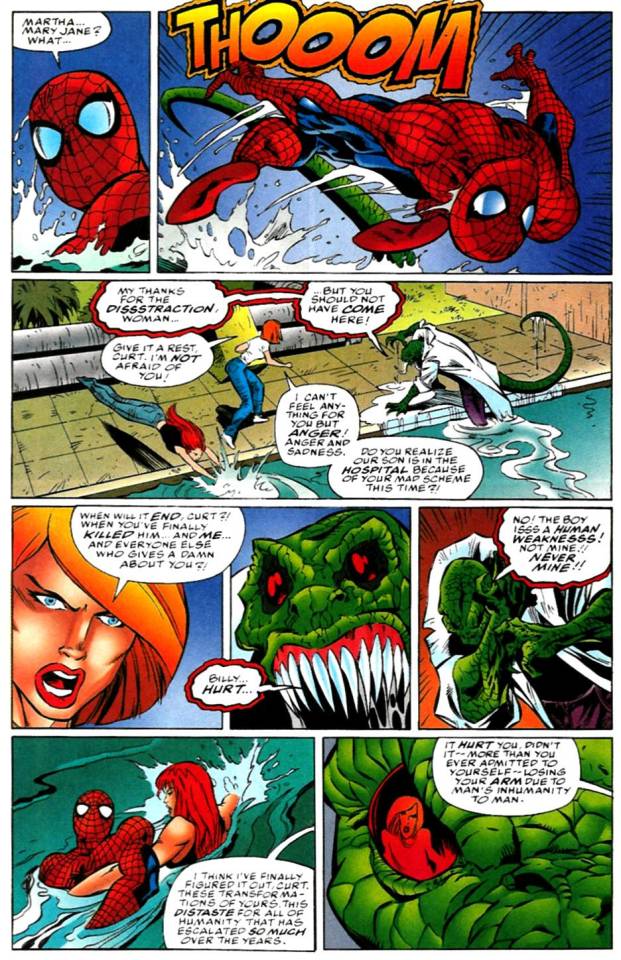
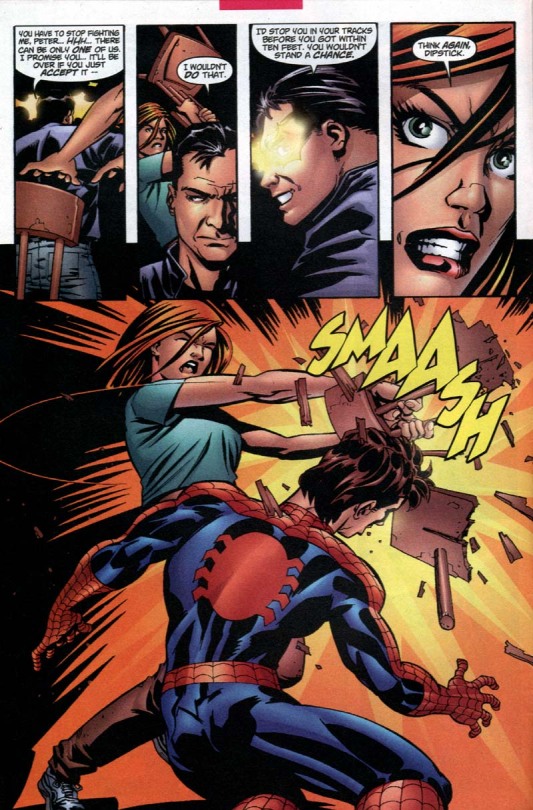


The problem though is that this comparison is kinda…disingenuous..
The key reason lies in the difference between Mary Jane and Peter’s comparative skills, abilities and experiences.
Spider-Man possesses…
natural abilities
reliable access to equipment and resources
years of experience
…that give him natural advantages over any non-powered civilian in dangerous situations.
He is physically more powerful than any normal human being.
It’s not even that he can just do anything a normal human could theoretically do but better. That is to say, it’s not just that he can lift more, sprint faster, perform better acrobatics and heal faster than a normal human being.
His powers simply transcend the capabilities of the normal human body. No normal human being can adhere to walls. No normal human being has a precognitive sense of almost any and all kinds of danger, whether it’s a holstered gun or some spoiled food.
Additionally the vast majority of human beings lack Peter’s scientific acumen (which does play into combat conditions a lot of the time) as well as his (relatively) unique web-shooters. He is also witty and adept at strategic thinking, most famously employing humour to throw opponents off opening up exploitable opportunities in battle.
Peter’s skills, abilities and equipment have been further enhanced through over ten years of on-the-job experience. This has given him athletic levels of muscle memory in combat and even developed his body to the point where he is incredibly fit even when his powers are removed, as witnessed in ASM #341.

All this taken collectively means that Spider-Man is incredibly formidable fighter for almost any individual or group, be they super powered or otherwise.**
Nine times out of ten he has the options of:
Tricking/outthinking his opponents
Wearing them out
Surviving many attacks lethal to normal people, enabling him to either find an opening later or save civilians
Simply physically subduing them with his body or webbing
Rendering them unconscious (or technically even killing) them with his strength***
Using his scientific acumen to outright invent a solution to a dangerous problem. This can include modified versions of his webbing tailored to an opponent’s weakness
Turning groups against one another
Disarming them
Intimidating them
Getting inside their head
Spidey cannot simply pick any one of these options against any opponent. But the number of options available to him means that he has a high probability of at least one of them working.
It also means he has a pretty good chance of success against a wide variety of opponents, even if they have an edge over him in one or more capacities.
Using his resourcefulness and scientific intellect, he has defeated Morlun multiple times despite him having vastly superior strength and durability than Spider-Man himself.

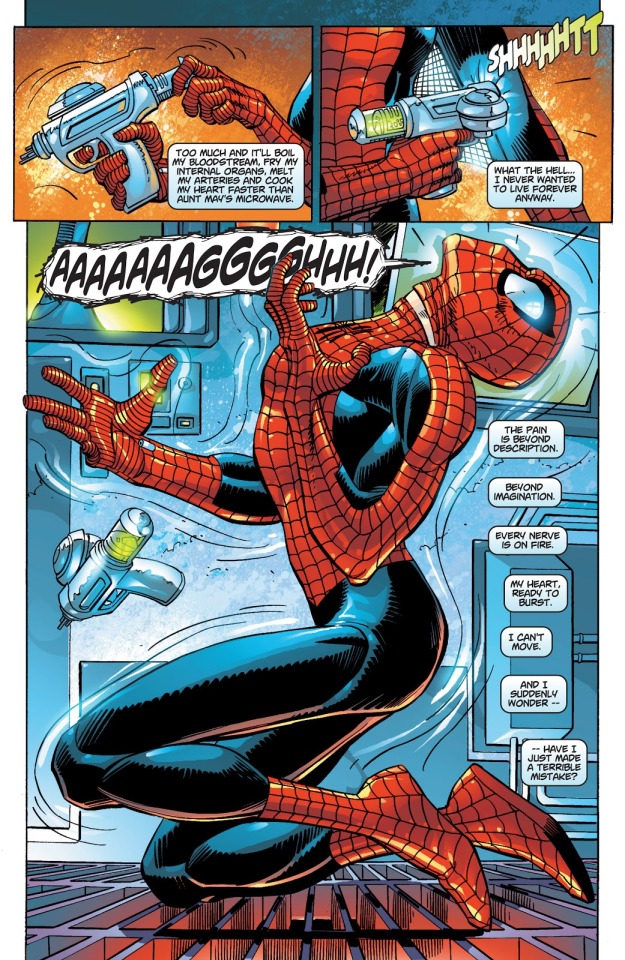
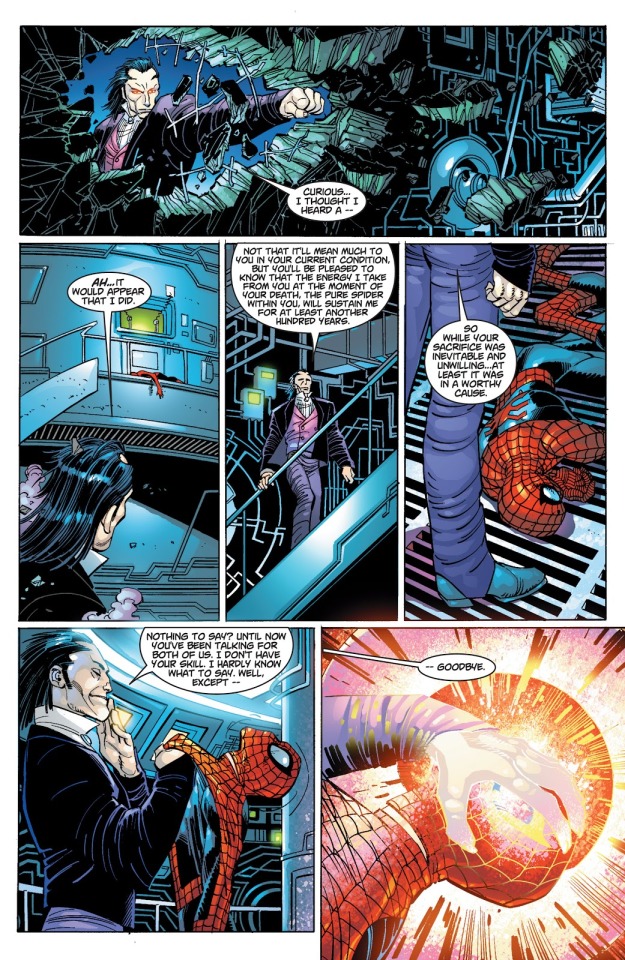
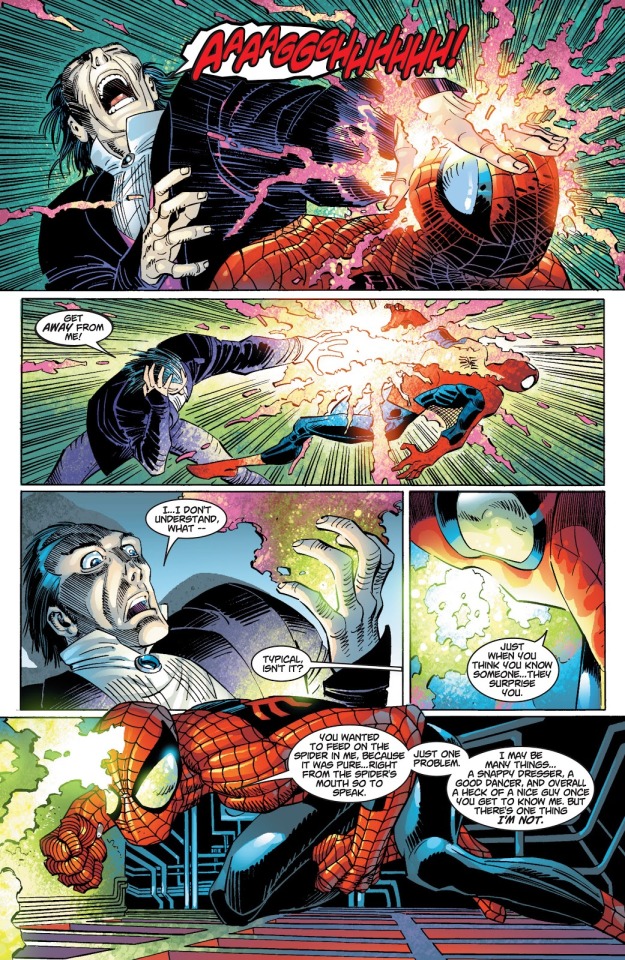
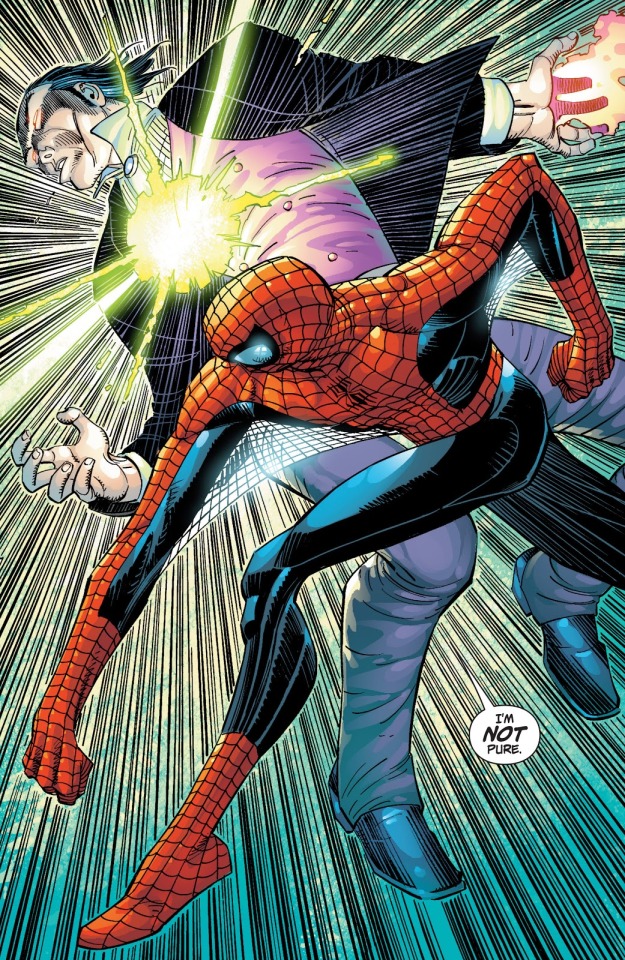
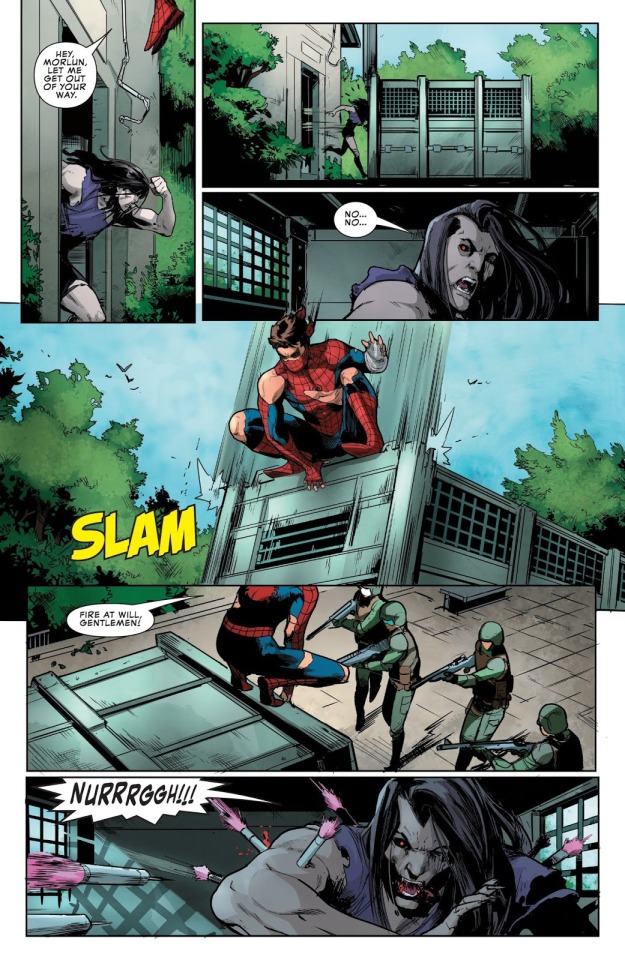
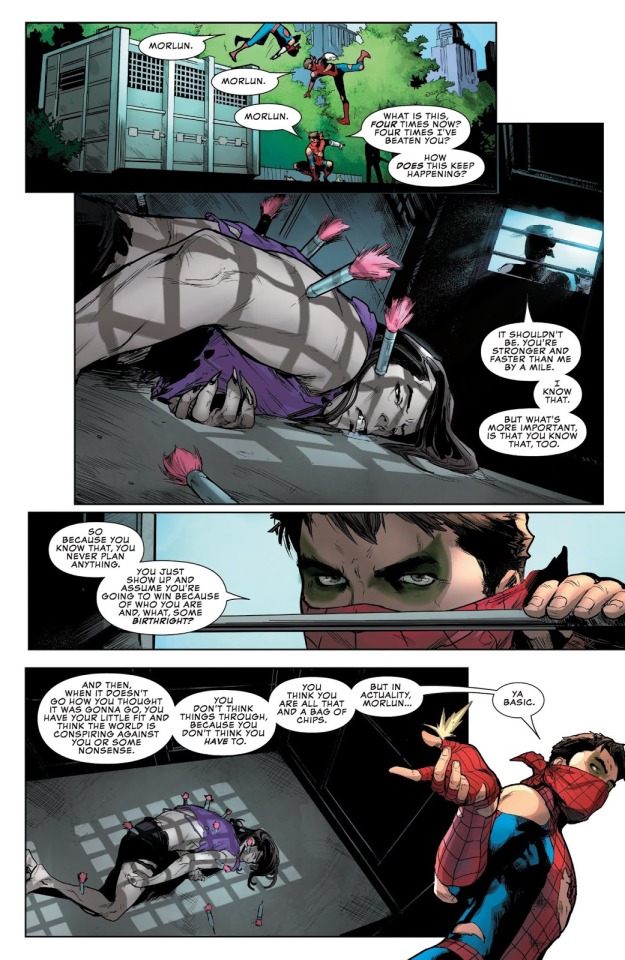
His fighting skills are such that he can hold his own against Captain America who’s generally more experienced than Spider-Man and a superior hand-to-hand fighter and strategist.



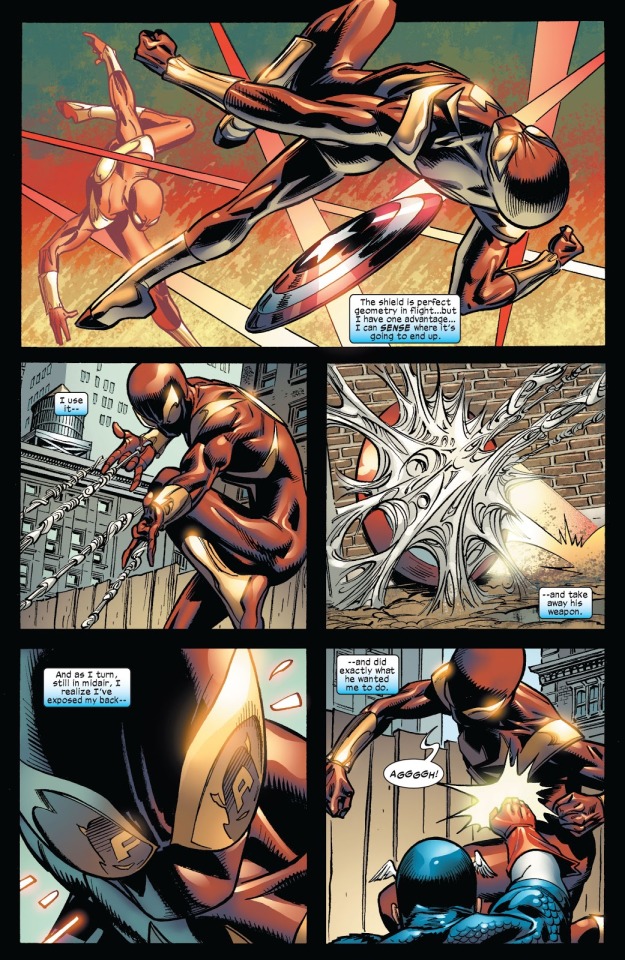

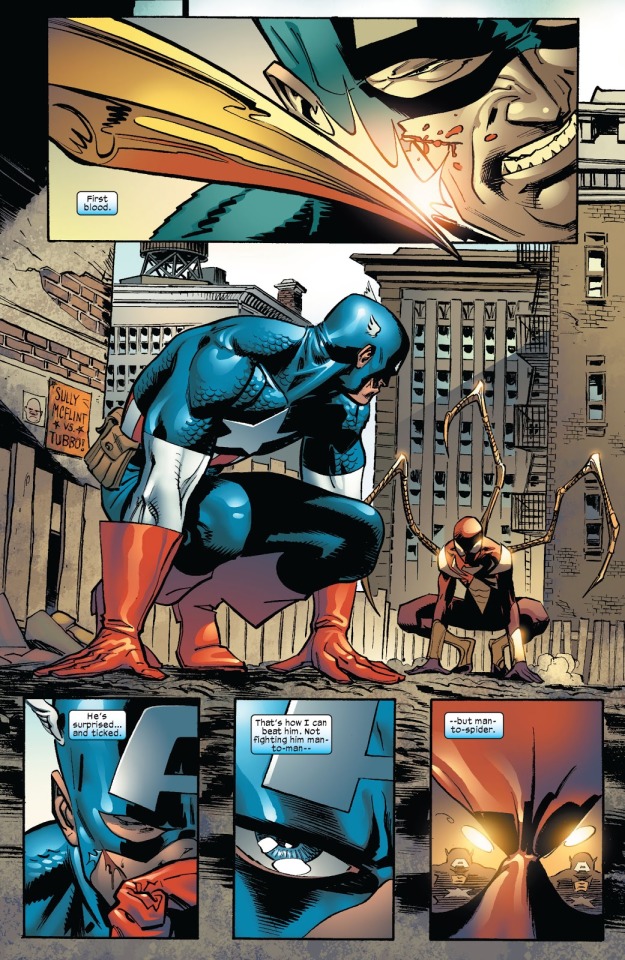
He’s defeated a whole group of the X-Men, whose experience, teamwork, raw power and diverse abilities make them incredibly formidable.



His fighting prowess is such that he was unable to be defeated by a similarly diverse group of heroes known as the New Warriors. Whilst the New Warriors are not the measure of the X-Men what made this impressive was that (due to mind control) Spider-Man was actively trying to let them win.

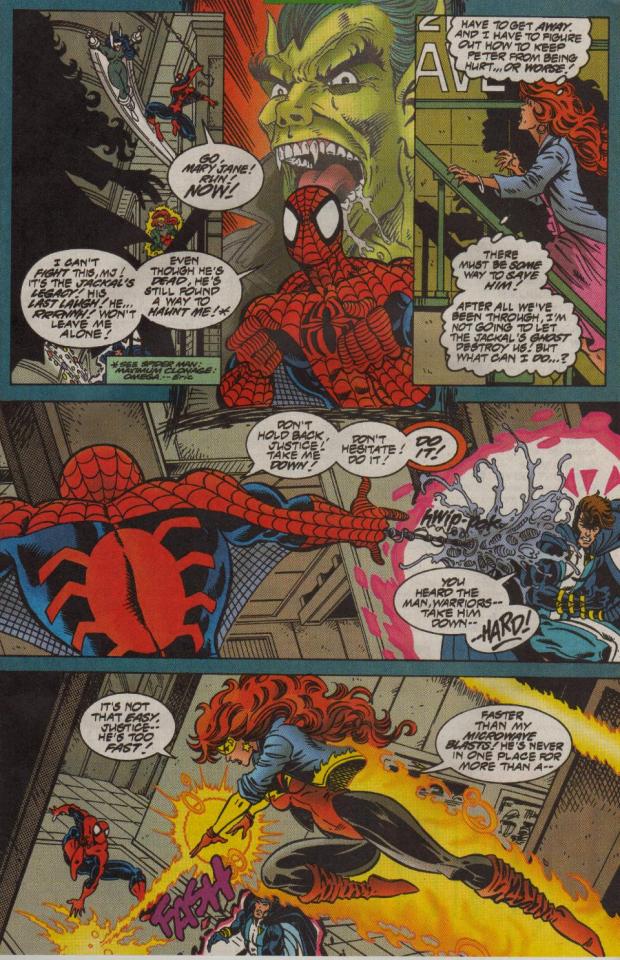
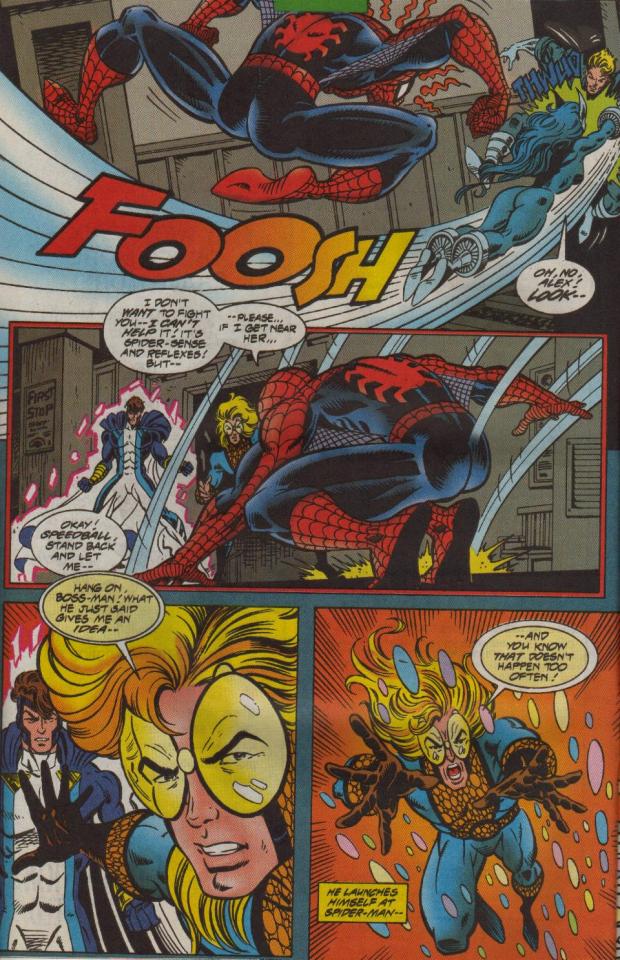
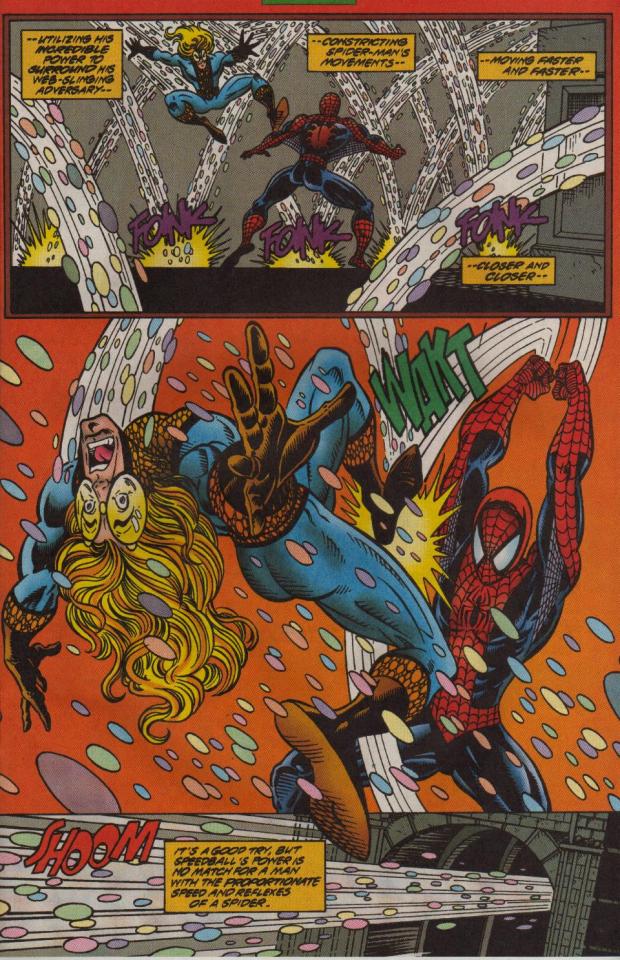
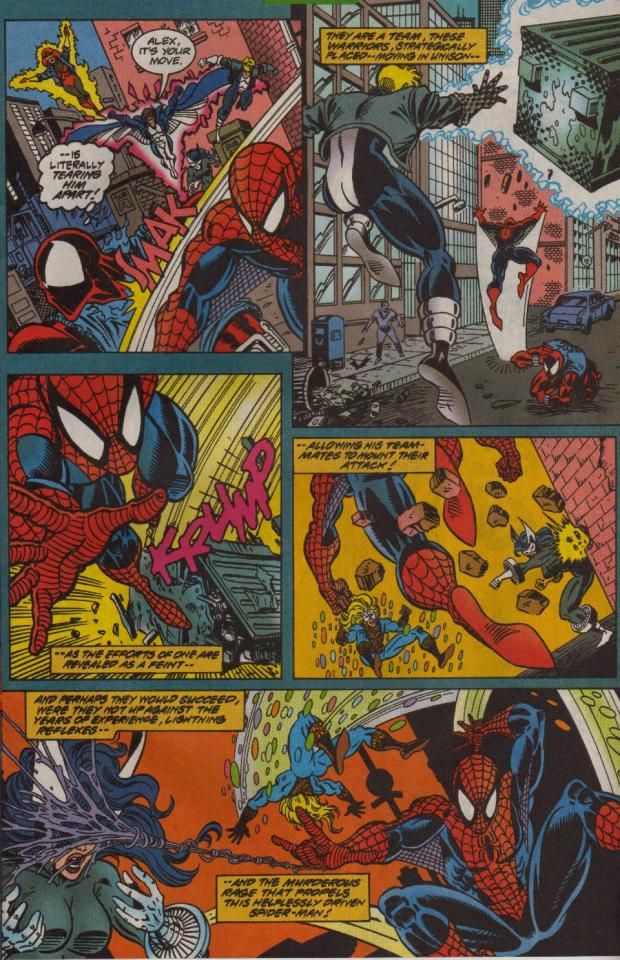
Even so, there are people very much out of Spider-Man’s league. For example, Spider-Man does not usually pick fights with Magneto, Mephisto, Ultron or Galactus. He rationally understands that he would have no hope of defeating such people and leaves them to better suited heroes like the X-Men, Doctor Strange, the Fantastic Four and the Avengers.
Spider-Man is not stupid, arrogant nor self-destructive. Like MJ, he is aware of his limitations; although he does at times underestimate himself. If he regards a threat as out of his league, even one more directly connected to himself, he knows to seek help. This is exemplified in ASM #361 after he has proven incapable of defeating Carnage on his own. He tries to call the Avengers or F4 for help but they are unavailable, forcing Spidey to team up with Venom.
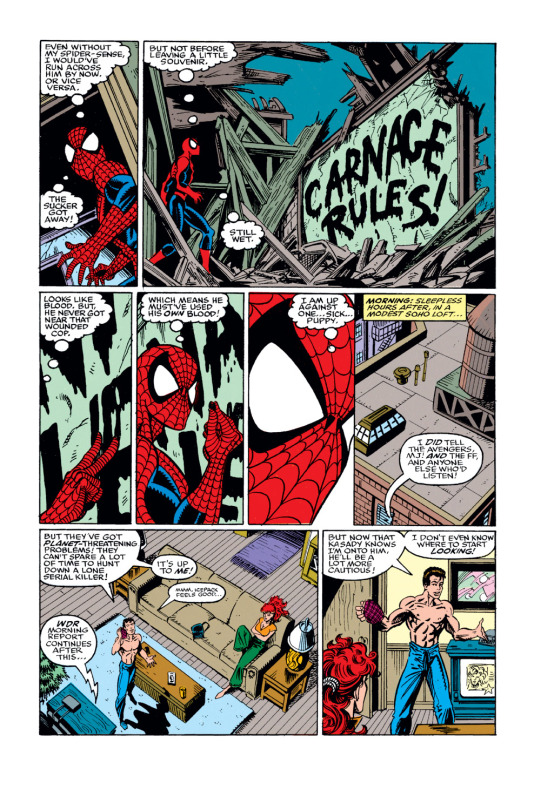
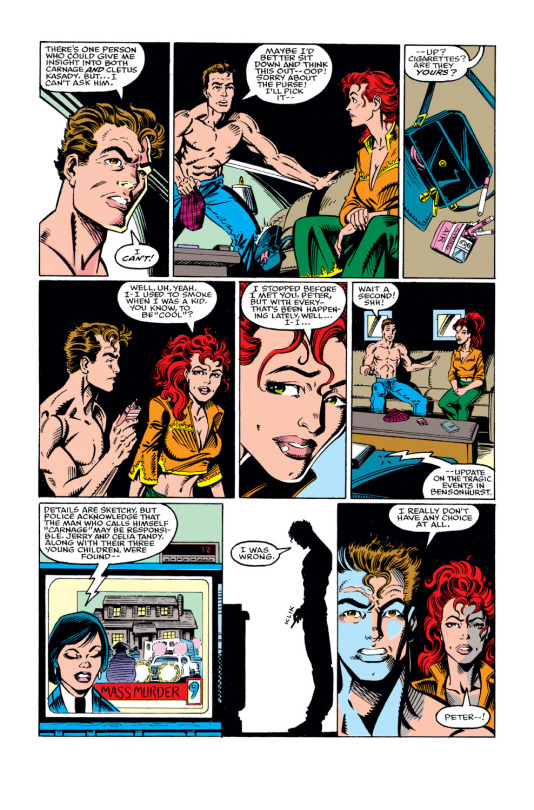
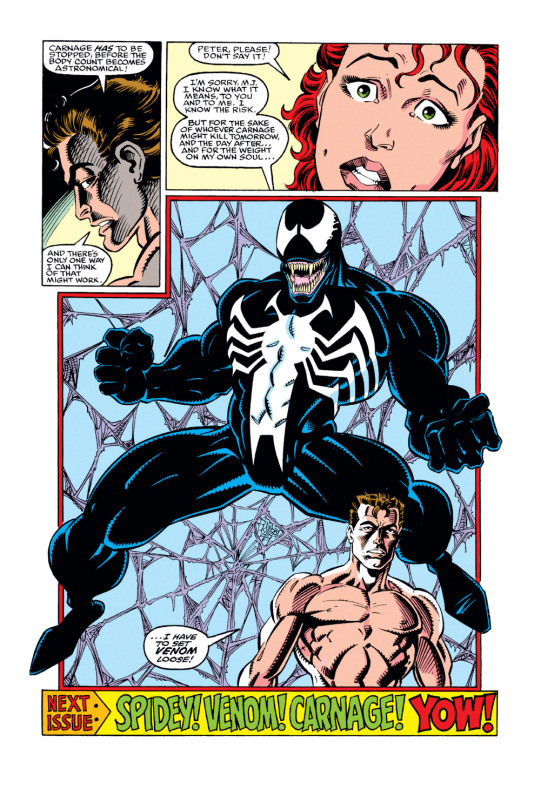
Hmm, up against dangerous overwhelmingly odds and calling for help? Could this perhaps be something Mary Jane should consider in AMJ?
Only when he has no other options does Spidey chosen to fight people he doesn’t believe he has much (if any) chance of beating.
A classic example of this is ASM #269 when Firelord tried to kill him.
For context Firelord is a former Herald of Galactus, putting him relatively close to the power level of cosmically empowered beings like the Silver Surfer and Thor.
Peter tried to find the Fantastic Four, who had experience dealing with Galactus and his Heralds.
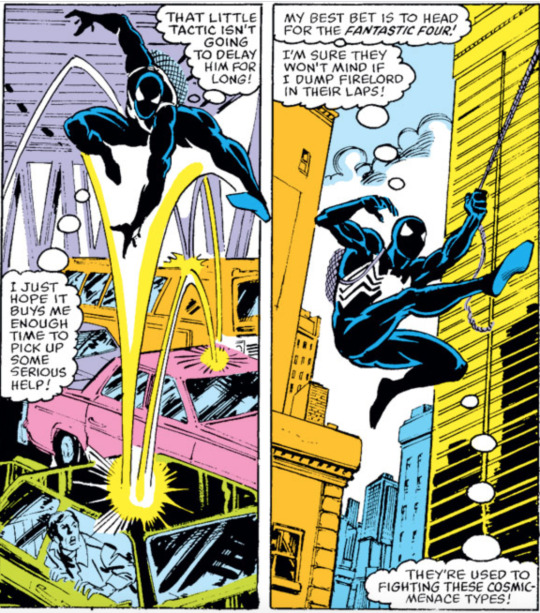
En route he even mentioned how the Avengers were better suited to handling guys like Firelord compared to himself.

Unfortunately the F4 were completely unavailable.

Peter considers going to the Avengers but realises with Firelord speed he’d be unable to reach them in time. Briefly, Peter considers simply changing into Peter Parker and avoiding Firelord altogether. However, his sense of responsibility compels him to fight in case Firelord hurts someone in his search for Spidey.
Thus Peter resolves to defeat someone who seems to outmatch him.
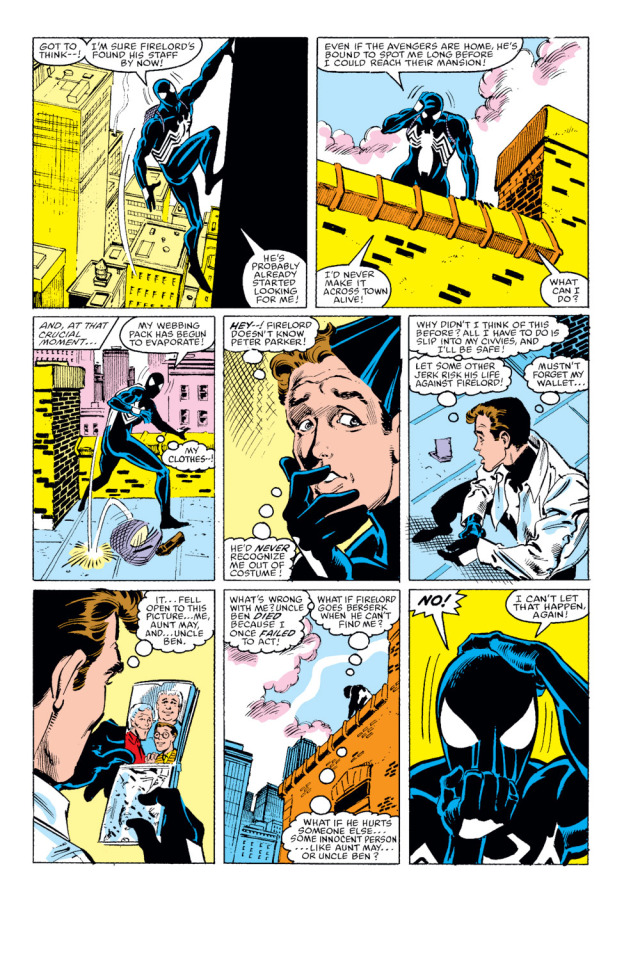

But now let’s compare all this to Mary Jane.
MJ is certainly smart and resourceful. This then means she can outthink her opponents and get inside their heads as Spider-Man does at times.
But like I said above, Spidey has many more options than just those ones.
MJ lacks Peter’s specific scientific acumen, which limits her abilities to draw upon that to mitigate dangers. She cannot for instance invent a gadget or chemical tailored to a specific problem. There might even be viable solutions to a problem in the heat of the moment she is unaware of because you’d need a college degree in bio-chem to realise them.
Regardless of sex or gender, as a normal human Mary Jane is simply less capable of surviving physical attacks compared to Spider-Man.
She cannot move nearly as fast as him, nor even as fast as normal yet trained heroes.
Her strength level is average for someone of her height and build.
She usually doesn’t have access to unique weapons like web-shooters, nor even regular firearms (not that these are usually effective against super villains). Even if she were to have a set in her possession her ability to use them would be limited because she doesn’t know how to create or maintain them. Were they to be damaged, lost or run out of web-fluid she would need to turn to a third party to get them working again. In contrast Peter could create web-shooters from scratch with fairly limited resources.
And were MJ to have web-shooters she cannot optimise their use because she doesn’t have Peter’s other powers. She cannot combine strength, agility, wall-crawling and spider sense to bounce around a room, swing across a rooftop or even fire off rapid and highly accurate shots at opponents.
She doesn’t even have a mere precognitive danger sense, the single most useful power when dealing with Mysterio.
And her muscle memory, her battle instinct if you will, are pretty impressive but nowhere near to the levels of Spider-Man’s or most super heroes. MJ’s action amidst danger is not even half as regular as Peter’s. Peter has dealt with at least small-scale criminals for the vast majority of his adult life. It’s the difference between someone who plays a sport on every weekend for five years vs. someone who has played that sport practically every day for 10 years. The latter’s instincts and reactions are simply going to be better than the former’s.
Basically, unless there are very specific extenuating circumstances, Peter Parker enters into any situation objectively safer than Mary Jane.
He has objectively greater chances of surviving and ensuring the survival of others than she does. That would hold true even if Mary Jane is armed with a gun and is mentally prepared for what was to come.
In most dangerous situations Peter is highly likely to be ‘punching down’ whilst MJ would be ‘punching up’.
This doesn’t mean he’s guaranteed of victory at all, but when it comes to dealing with criminals or super villains his chances are reliably high whilst MJ’s are far less reliable.
And those chances, that reliability? It’s mostly internal, a hardwired aspect of his very being .
Outside of exceptional circumstances his powers, experience and intelligence can’t be taken away from him. He will always be armed with that stuff no matter where he is. Even his web-shooters are tools he invented from (expensive yet) easily obtained resources and they are not strictly essential to his combat abilities. Were he to find himself without them amidst most dangerous situations, his chances for protecting himself and others wouldn’t be close to nil by any means and he could simply recreate them with time.
These skills mean he’s only intermittently reliant upon others in combat situations. Usually he could get himself or others to safety or diffuse most threats that crop up. Similarly his need of luck is greatly reduced. Of course luck has often saved his bacon but it hasn’t been a near systemic requirement. Even in his early career neither luck nor assistance played much (if any) role in his initial victories over the Vulture, Doctor Octopus, the Scorpion and many other opponents.
Mary Jane in contrast lacks these internal skills. She has other internal skills that can aid her and prove invaluable, but they don’t amount to reliably giving her a chance in the majority of combat situations. Not without external factors (luck, assistance, etc.) aiding her. As we discussed in the prior instalment, that’s actually how she has endured the majority of hazardous encounters in her time.
To use the sports analogy again, Peter would be a professional NBA player who is at least proficient in all positions on the court and Mary Jane would be an amateur player who practices on the weekend but only in one or two positions. Peter could go up against at least a large number of other players and stand a reasonable chance and possibly carry the team over all.
But for Mary Jane to stand a fair chance she’d need a lot more things to go her way. The right opponent(s), the right opportunities presenting themselves, the right amount of support from her team mates etc. The fact that she’s played a few games and held her own, even won some outright, is a testament to her inner talent. But as a basketball player she’s just not on the same level as Peter, or Black Widow or She-Hulk or Wonder Woman.
With all that context dispensed with let’s move onto a bigger question.
Given MJ’s abilities and combat history is she capable of preventing Mysterio and his cronies from harming her self and others?
*In fact Spider-Man has tended to fight more effectively against groups of opponents as his speed enables him to move between them and use his opponents against one another.
This is partially due to the fact that Spider-Man’s skills in tandem give him an incredibly unique fighting style that no one without his powers can possibly replicate.
**It should be noted that Spider-Man typically restrains his strength on a conscious and unconscious level. He knowingly adjusts the amount of force he applies depending upon his opponents but he also restrains himself without realizing it. The result is that the depth of Spider-Man’s strength level is often surprising for him and his enemies. This is exemplified in ASM #700, when Doctor Octopus in Spider-Man’s body accidentally punches off the jaw of the Scorpion, someone who was designed to have superior strength to Spider-Man. Doc Ock himself is shocked to realize just how much Spider-Man held back.

Previous Part
Next Part
Master Post
#Spider-Man#Mysterio#Peter Parker#mjwatsonedit#mary jane watson#Mary Jane Watson Parker#MJ Watson#Quentin Beck#Leah Williams#Amazing Mary Jane#Captain America#Steve Rogers#Firelord#Avengers#Fantastic Four#Scorpion#Superior Spider-Man#Mac Gargan#Doc Ock#otto octavius#Doctor Octopus#Morlun#X-Men#Carnage#Venom#New Warriors#Carnage Symbiote#Venom Symbiote
8 notes
·
View notes
Note
Speeding bullet - scout being really braggy and boastful while 'trying' to get sniper into bed and when sniper finally agrees Scout is rlly fuckin insecure bc he didn't think it would work
scout tf2 all “ooh i got big dick energy” until he’s gotta get his dick out. ft. trans sniper because i fuckin feel like it
-
It was only half-joking, yeah, but that still meant that half of it was a joke.
It mostly started as just… an extension of what Scout was already kind of doing. It had started on him trying to get Snioer to laugh, and when it turned out he liked doing that, he’d worked hard to dig up all sorts of material. Puns and lame dad jokes and stuff, mostly. Then when he’d run low on those, he moved on to cheesy pickup lines. Then eventually he moved on to just regular pickup lines, then it somehow morphed into straight up flirting.
Kissy faces at Sniper across the room when he was trying to focus on a different conversation and pretending he hadn’t been doing anything when the other person looked was one of them that he had fun with for a while. Offhandedly saying “hot” when Sniper did normal, regular things, because to be fair, Sniper was a real attractive dude. Sniper occasionally bopping him on the shoulder for a sassy remark, to which Scout would make a dramatic noise and go “harder” just to make Sniper blush. Casually calling Sniper “babe” or “hon” when he wasn’t really paying attention just to see him sputter a bit.
He didn’t think it was ever gonna go anywhere, not just on the basis of it mostly being a joke, but also because Sniper was wayyy out of Scout’s league, as far as he was concerned. Mysterious Australian marksman, tall and handsome, real sweet and awfully polite in a way that made him the exact kind of guy Scout would’ve wanted to bring home to his Ma back when he lived in Boston and was still trying to date for real.
And he knew Sniper was into dudes, had gathered as much when Sniper one day quietly murmured some remark about an ex-boyfriend and promptly tried to brush past it. But that didn’t necessarily mean he was into Scout.
But he liked the way Sniper’s mouth ticked up at the corner when he hit him with a really good pick up line. Liked the way Sniper would sometimes roll his eyes, sometimes flush, sometimes sputter and smack his shoulder. It was nice, the thing they had going. Friends, but better than coworker friends, but kind of different than friends. It was a weird dynamic they had going on.
They were in Scout’s room one day, playing checkers on the shitty little board Scout had picked up from a thrift store at some point and never gotten around to throwing away. Sitting across from each other with the board between them on Scout’s bed, Scout criss-cross and Sniper half-lounged against the wall.
Sniper finished off his last two pieces in a double jump, and Scout swore, having lost track of the piece responsible.
“You suck, dude,” Scout complained, picking up the pieces and stacking them with the rest of his own.
“Mate, you suck,” Sniper corrected.
“Only on weekends,” Scout shot back, only a second delayed, and winked. “But hey, I can make exceptions.”
“Is that right?” Sniper asked.
This was a new bit. Sniper didn’t usually push the joke forward, or prompt him for more. Scout rolled with it. “Yeah, man,” he laughed. “I can start taking walk-in appointments for a nice face.”
“How far do you schedule in advance?” Sniper asked next, raising an eyebrow.
“Not too busy these days,” Scout shrugged.
“Might be able to say you’re able to… squeeze someone in?” Sniper asked, and Scout’s heart hammered, even as he burst into laughter.
“Aw, fuck, that’s a good line. Jesus, I’m mad I didn’t think of that first,” he managed, and Sniper was smiling too, looked away after a second.
“Thanks, mate,” he replied, looking satisfied. He shifted, not looking back. “You’d think there’d be a waiting list a mile long.”
“Fuckin’ tell me about it,” Scout groaned, leaning back to get a bit more comfortable. “I mean, seriously. There’s like nobody out here. Unless I wanna dick down on some sand or whatever, I’m shit outta luck. And most of the people in town are way too old for me, and the people that ain’t are like, either taken or super weird or just not interested. And yeah, one or two are all clear, everything’s fine, but the second the word relationship crops up, poof, gone, smoke cloud, fuckin’ witness protection levels of disappeared. What’s a guy gotta do to get appreciated a little around here, y’know?”
Sniper nodded and hummed sympathetically. “Well, I’m sure there’s one or two people around who can tell a good thing when they see it,” he said, tilting his head.
“We talkin’ besides you?” Scout asked, grinning and starting to gesture at himself. “I mean, look at this, look at all’a this! No duh, I know you’ve got two workin’ eyes and at least a little bit of taste. Even if your food is fucked up and weird.”
Sniper rolled his eyes, but he was smiling. “Humble, are we?”
“What, am I supposed to be?” Scout asked, cheeky and unapologetic.
“It’s alright. It’s cute,” Sniper replied, glancing him up and down.
Scout flushed. The tables weren’t usually turned like this, and it was taking surprisingly little to fluster him. “Thanks,” was all he could think of. He cursed himself for not having a better line. “I mean, yeah. Of course I am. Uh, it is. Fuck.”
Sniper chuckled, and sat up. “Thought you usually hate it when people call you cute,” he pointed out, tilting his head back and forth to stretch his neck where he’d been sitting weird.
“I mean, it’s okay if it’s… you,” Scout said, words slowing as he realized how sappy that sounded. “I—I’d be okay with—“
He stammered a little, distracted by the visual of Sniper pulling off his shades, which he almost never did, and folding them up, setting them off to one side and fixing him with a look, eyes sharp and overwhelming now that they were uncovered and Scout was faced with the absolute brunt of them.
“—I mean I-I-I’d be okay with all sorts of things,” he said, a little desperate to turn the conversation back to their standard flirty jokes. He felt way out of his depth all of a sudden and it made him a little uncomfortable.
Then every muscle in Scout’s body froze as Sniper moved forward.
He knocked over their little stacks of checker chips with his knee, sending a few in a lazy topple down off the bed towards the floor, and a gentle push to Scout’s shoulder was all it took to make him fall back onto his back, and then Sniper was over him, on top of him, inside of his thigh against the outside of Scout’s propped up on his arms.
“What sorts of things?” Sniper prompted quietly.
Scout’s breath caught, staring up at Sniper with wide eyes.
After a few seconds of silence, Sniper’s eyebrows started to furrow. “You awright, mate?” he asked gently.
“Yeah! Yeah, for sure,” Scout said right away, fumbling to try and find a good place to put his hands, settling on Sniper’s shoulders despite the awkward bend it put into his elbows between them.
“Are you… not ready, to…?” he started to ask next, trailing a little, and Scout was faced with a series of concepts. That Sniper thought their arrangement was one where Scout could be ready for this. That Sniper thought they had some kind of arrangement. That Sniper wanted him.
The last one buzzed around in his head hard enough that Scout didn’t even remember to respond.
“We can stop,” Sniper said next, and Scout fumbled for a good reply.
“No! No, I’m good. It’s good,” he said, trying to calm his hammering pulse.
Sniper sat up a little, glancing him up and down again. “It just seems like you’re nervous is all,” he said.
And he was, and he was sure his hands would be shaking if they weren’t holding on to Sniper’s shoulders. “I’m good,” he said anyways. “I just—I dunno what you, what you like, what you want.”
“I could ask you the same thing,” Sniper replied, and Scout had to fight hard not to jump at the feeling of Sniper trailing a hand down his side. “What do you want to do?”
Scout swallowed hard. “Can,” he started to ask, and he didn’t know how he could be reading this wrong but he was sure that he was, had to be, felt this was an insane thing to be able to request but Sniper had asked so he tried anyways, “can I touch you?”
Sniper shrugged, sitting up just slightly further, squaring his shoulders to open himself up. “Go ahead,” he prompted, and Scout did.
He managed to undo the buttons of Sniper’s shirt, pushing it down his shoulders a little ways before he realized he had an undershirt on and that it would need to go as well. A glance up at Sniper, and Sniper chuckled, sat back slightly, pulled off his shirt and undershirt both before he leaned back forward within range of Scout’s hands.
Scout traced across all the scars he could find with gentle fingers, trailing them momentarily over two large scars there at Sniper’s pecs. “How’d you get these?” he asked, glanced up at Sniper.
Sniper frowned. “Mate, I’ve told you already,” he said quietly, and Scout took a good few moments to realize what Sniper meant, then looked down again with wide eyes.
Somehow the words “top surgery” hadn’t brought him the mental image of big, wide scars. Suddenly he was all the more impressed with Sniper. “Oh yeah,” he said, tracing over them again. “Huh.”
Sniper fixed him with a befuddled smile, the sort of fond “are you serious, how’d you forget that?” look he tended to get from people who actually liked him, and Scout could only smile back sheepishly. Finally Sniper rolled his eyes and plucked on Scout’s shirt. “Planning on ever taking this off?” he asked, and Scout quickly nodded, trying to wrestle himself free of the shirt as fast as he could. “Easy, mate. No time limit, here.”
“I know!” Scout said a little defensively, finally getting the shirt off over his head, and Sniper smoothed down the hair on one side of his head where it was probably sticking up and looking dumb.
God, he probably looked so dumb. There lying beneath a big, cool guy like Sniper, all… scrawny and already flushing and not a single cool scar to speak of—
“Mate, it’s alright if you’re nervous,” Sniper said, worry increasing.
“No I’m not nervous why would I be nervous I’m totally cool,” Scout said all in a rush.
Sniper raised an eyebrow, unimpressed.
“I mean, maybe a little a little nervous, but just because I—“ And he realized it in the same moment he fished through his head for an excuse. “I just don’t have anything to… y’know, stuff we might need.”
Sniper stared, waiting for him to elaborate.
“I don’t have any condoms or anything on me,” Scout finally admitted, surely flushed down to his chest.
Sniper’s lips parted around a silent “oh”, and he nodded. “Awright. Well, that’s fine, still plenty we can do,” he decided aloud after a second. “How’s about I tug you off, you do the same for me?”
Scout didn’t know how he was in a situation where it was acceptable to ask the thing he blurted a second later, but thank god that he was. “Can I go down on you?” he asked, not entirely sure what words he would use in the specific and not wanting to be super rude and ask.
Sniper laughed, grinning. “Sure, mate. If you want,” he nodded. Another look up and down. “Mind if I get you off first, though? I’ll admit, I’ve, er, been looking forward to the chance a bit.”
“Go ahead,” Scout said weakly, and Sniper’s grin widened, and he moved to work Scout’s pants open in simple, confident motions.
It was a little embarrassing that he was so hard already, and he had to look away from Sniper, tilting his head back to look at the ceiling. Sniper hummed, and then spit into his hand, and then he was jacking Scout off, steady and nice.
“How’s that?” he prompted softly into Scout’s collarbone when all Scout did for a while was pant and gasp quietly.
“S’good,” he managed, voice shaky. “Real good. Real fuckin’ good.”
So good that he felt a moan rising up in his chest and pressed his hand against his mouth, biting down on the meaty part of his palm to try to stifle it.
“Oh, no,” Sniper chided, voice a growl, taking Scout’s wrist and pinning it just to one side of him, grinning. “I wanna hear you.”
Scout started to protest, but then Sniper squeezed nice nice nice over the head and it made his lashes flutter, his back arch, his mouth fall open in a gasp trailed by a moan, and his face was absolutely on fire.
“There’s a beauty,” Sniper purred, and pulled his hand back to spit in it a second time before he returned, picking up speed and apparently greatly enjoying the way Scout squirmed, the noises that rose up in his throat. “There you go. Nice, aren’t it?”
“Yeah,” Scout agreed, and he wished he could shut up, wished he could shut his big fuckin’ mouth for a minute before he embarrassed himself, but he couldn’t, could only whimper out praises and pleads as Sniper drew him closer to, and finally over, the edge, heralded by a weak groan and Sniper’s name.
He came back down to earth to the feeling of lips and stubble against his cheek, his jaw. Scout blindly fumbled with his newly-freed hand towards his dresser, managing to find the tissues and mop himself off, still flushed, thoroughly embarrassed.
“Cute,” Sniper hummed, looking down at him, and Scout groaned, head falling back for a second to finish collecting himself.
“Uh,” he tried to say, blinked once or twice, looked at Sniper. “Hey, let me hit you with somethin’ real quick.”
“Mm?” Sniper asked, mildly intrigued.
“How about you, uh.” And usually he was so much smoother, way cooler, but Sniper had him frazzled in a way that most people didn’t, not even that really hot guy he met the year after he graduated, the one with the leather jacket and the cologne that made him practically lightheaded. He fumbled for a way to phrase it that was hot, but couldn’t seem to find anything, and just sighed, spitting it out and cutting the bullshit. “How about you sit on my face?”
Because in a cursory glance, he’d noticed that while Sniper was smiling, movements languid and smooth in a way that meant he was very much into the proceedings, he didn’t seem to have a bulge in his pants, there being no hardness to speak of when he ground his hips forward into Scout’s thigh. And apparently he’d made the right call, because Sniper chuckled and agreed.
And to be honest, he didn’t remember much after that. It was mostly a haze, movement and heat, Sniper’s husky voice dripping into his ears much in the same way that slickness dropped down Scout’s chin and cheeks. All he knew was that Sniper was gorgeous, and seemed to like what Scout could do with his mouth—and damn right he did, he had enough experience that he would be a little insulted otherwise. All he knew was that halfway through he found himself outright hard again, and wound up jerking himself off desperately with his free even as he continued trying to wring noises out of Sniper with mouth and fingers, muffled groans escaping him as Sniper decided to tease him about it in that low raspy voice he was starting to get addicted to.
Sniper finished first, and the rush he got feeling Sniper’s legs close right around his head drove him over the edge, bucking and making Sniper roll forward slightly and prolonging things for him.
And finally Sniper was leaning up onto his knees, reaching for the same tissues Scout had gone for earlier and laughing at the picture Scout made. His hair was all stuck up on one side again, he was pretty sure, and his face was red and shiny with wetness, lips swollen and parted as he panted, staring up at Sniper with bright eyes.
“We gotta do this again some time,” Scout said before Sniper was even done wiping himself down.
And Sniper laughed. “Sure, mate. Any day of the week.”
15 notes
·
View notes
Text
Dust Volume Five, Number 11

Cold rain, dead leaves, political corruption, diplomatic betrayal…it’s been a bleak couple of weeks on the home front, but at least the music is good. This time out, we check in with the estimable Ezra Furman (pictured above) and his blistering punk rock album, as well as a smattering of shoegaze, a low frequency trio, a black metal endurance test, acoustic entropy and the sound of black holes colliding. You know, same old, same old. Our contributors include Andrew Forell, Bill Meyer, Jennifer Kelly, Jonathan Shaw and Ian Mathers.
Blushing — Blushing (Wallflower Records)
Blushing by Blushing
Blasting out of Austin, Texas come Blushing (married couples Michelle and Jacob Soto on guitar/vocals and drums, Christina and Noe Carmona on vocals/bass and guitar) with their self-titled debut album, an impressively sophisticated addition to the shoegaze landscape. Blushing displays finely tuned dynamics, a keen sense of melody and joyous rushes of controlled noise. The interplay of twin vocals adds an ethereal Cocteau Twins sheen to the songs but Blushing aren’t afraid to let rip with layers of guitar. Producer Elliott Frazier of Ringo Deathstarr achieves space and separation in the mix that elevates this album above the basic quiet-loud-quiet formula. Underpinning all this is simply terrific songwriting and musicianship. Opener “So Many” starts with whispered vocals over strums and washes of guitar before the rhythm section enters, there’s a slow build before the track blossoms into a widescreen squall of almost psychedelic guitars and pounding drums then wanes into a feedback outro. Highlights “Dream Merchants” and “The Truth” bring classic shoegaze tropes and add a dreamy panoramic depth. Blushing is a band to watch and this is a gem of a debut.
Andrew Forell
CARL — Solid Bottom (Astral Spirits)
Solid Bottom by CARL
“Bass, how low can you go?” CARL’s flow differs drastically from Mike D’s, but the question is undeniably pertinent. The Houston-based trio comprises three low end instruments — Damon Smith (since departed) on double bass, Andrew Durham on electric bass and radio, and bandleader Danny Kamins on baritone saxophone — hitting sonorities that range from ankle high to sub-sub-basement. But bulbous pitches can still be nimble, and so it is here. The interaction pits genre against genre, bow thrust against amp buzz, melancholy phrase against floor-rattling rumble, resulting in music that never feels at ease. Hey, Texas needs some opposition, and these folks are ready to show the way.
Bill Meyer
Ezra Furman—Twelve Nudes (Bella Union)
Twelve Nudes by Ezra Furman
It was about the time that Ezra Furman started expressing his distinct identity—queer, cross-dressed, devoutly Jewish—that he turned into one of rock’s great songwriters. Today, freed of the need for self-abnegation, his songs balance a razor-stropped wit with sharp, assaultive hooks; he is not afraid to tell you his story, though he’s too literate and clever to deliver it unadulterated. His songs have a shape and a sting at the end like a good short story, but a punch that is considerably more visceral. “The kids are just getting started/they’ve only just learned to howl, and most of them throw in the towel/by the time that they turn 23,” he shouts raspily in “Evening Prayer aka Justice” and it leads into the kind of stirring, anthemic chorus that Titus Andronicus used to be so good at. “What Can You Do But Rock and Roll” rampages in a short-circuiting stop-start attack, like Green Day before they got so serious about themselves. In short, it’s a rock and roll of the sort that the culture has mostly abandoned, the kind that large men push to the front of Hold Steady concerts for, that causes Japandroids fans to punch the air. And yet it is not wholly of this man-centric tradition, simply because of who Ezra Furman is – lipsticked, cocktail dressed, smarter than you and willing to talk Torah. In short, here is a songwriter who has been killing it since Day of the Dog and Twelve Nudes, his latest, punk-est album (inspired equally by Jay Reatard and the Canadian poet Anne Carson) may just be his best. He is of the zeitgeist and also not, and you kind of wish more people were paying attention.
Jennifer Kelly
Great Grandpa—Four of Arrows (Double Double Whammy)
Four of Arrows by Great Grandpa
“That’s why I hate you-ou,” cries Alex Menne in “Digger,” their voice catching in a hiccupping way that invites intimacy even at high volume. Her confidences are couched in an explosive swirl of country rocking countercurrents, concocted by the band’s two main songwriters, bassist and singer Carrie Goodwin and guitarist Pat Goodwin and executed alongside Dylan Hanwright (also guitar) and Cam LaFlam (drummer). The Seattle band’s second full-length is less brash and rock-centric than the 2017 debut Plastic Cough, which, perhaps because of their northwestern roots, elicited the term “grunge” from critics. This one is fuller, more elaborate and entirely devoid of Soundgarden references. It is decorated with lush, multi-voiced singing and baroque instrumental counterparts, and critically, uses a warmer more organic palette of instruments. That’s a violin and a banjo building out “English Garden,” not the buzz saw guitars of “Teen Challenge.” This rich, tuneful, grounded experiment might remind you of Ohmme, Hop Along or the Moondoggies, sleek but vulnerable, blown out but in control.
Jennifer Kelly
Hatchie — Keepsake (Double Double Whammy/Ivy League/Heavenly Recordings)
youtube
Could it somehow be the fact that Harriette Pilbeam (late of Aussie indie rock band Babaganouj and here aka Hatchie, a family nickname) plays bass instead of the more standard frontwoman guitar that makes the singer-songwriter’s debut LP of new wave dream pop confections so singularly striking? Probably not, but Keepsake is assured and ingratiating enough it does leave one looking for the secret ingredient. Whether it’s the swooning likes of “Without a Blush” or “Secret” or the rougher emotional and sonic texture of “Unwanted Guest,” whether it’s playing against a sampled loop of her own voice on the chorus of “Obsessed” or achieving a particular kind of downward gazing transcendence through drum machine and synthesizer on “Stay With Me,” all of the songs here manage to hit on just the right combination of genre-appropriate beauty in texture with genuinely impressive melodic songcraft that whether Pilbeam sticks with this sound or not, she’s one to watch.
Ian Mathers
Imperial Cult — Spasm of Light (Amor Fati/Sentient Ruin Laboratories)
Spasm of Light by Imperial Cult
This record consists of a single, 34-minute, largely improvised track, captured live in the studio. It’s all about endurance: the band’s, who must gamely thrash and bash at their instruments, with all of black metal’s requisite speed and intensity; and the listener’s, who has to commit a fairly significant amount of attention to the thing. Hailing from Holland, Imperial Cult are a new band, subscribing to the minimal web-presence policy of some other hyper-obscure acts, so it’s tough to say if they are of the “Satanists-and-we-really-mean-it” variety of continental black metal. If they are, the record’s grandiose gesture makes a certain sense. “Spasm of Light” may thematize the notion of eternal hellfire and torment. That, in turn, would raise other theological questions (do these guys imagine that declaring themselves devil worshippers and making this sort of music is their ticket out of forever in Bedlam? or are they looking forward to it?) that this reviewer isn’t all that interested in. More immediately concerning is the music. It’s pretty good, though to these ears, it’s more evocative of the epically inclined USBM bands of the Cascadian school — especially the early records of Ash Borer — than purposefully underground European occult acts like Novae Militiae (yes please) or Deathspell Omega (no thanks). Musically, that’s a good thing. Ideologically, who knows? Do these dudes wear cowls and sacrifice small mammals? Do you really want to know? Jonathan Shaw
Minor Pieces — The Heavy Steps of Dreaming (FatCat)
youtube
Just gorgeous. Tape hiss master Ian William Craig and a Vancouver-based songwriter named Missy Donaldson join forces in an album that hangs right in the spectral other-space between conventional song and ambient soundscape. Craig, who is a classically-trained singer, sings lead most of the time. His clear, vibrato-laced tones with clouds and miasmas of electronic wash, mass-y harmonies and fragmented bits of guitar and piano. The effect in opener “Rothko” is both luminously polished and dream-like. “Bravagallata” reaches further up the register, twining Craig’s androgynous, unearthly tenor with the warmth of nestling, caressing harmonies; it shimmers in the interstices between icy modernity and comforting folk song. “The Way We Are in Song,” arises out of glowing, shifting electronic tones, yet feels wholly natural and unaffected. The way we are in this song is beautiful, touchingly human, but more so.
Jennifer Kelly
The Pheromoans — County Lines (ALTER)
County Lines by The Pheromoans
The Pheromoans look at the world sideways, buttressing a workman-like rock and roll sound with murky embellishments of violin and synths. With a wobbly, wavery flavor of post-punk that might remind you, a little, of Blue Orchids, they match up dense woozy riffs with literate mumbles. They are the sort of band to ask “Sharia or Sheeran” and leave you shrugging, what’s the difference? This is the Pheromoans’ fifth full-length; their diaspora previously landed them on Upset! The Rhythm; but here the edges aren’t sharp enough, the punches not hard enough to evoke that label’s other bands. Yet there’s a disconsolate appeal to these wandering tracks. “Troll Attack” eviscerates electronic interaction against a Casio beat; both the music and the lyrics poke at unsatisfactory surfaces to find darker, truer muck underneath.
Jennifer Kelly
Matthew Revert — The Inpatient (Round Bale)
The Inpatient by Matthew Revert
Some people get ready for surgery by making a bowl of Jell-o and making sure that the Hulu bill is paid up. Not Matthew Revert. His preparation for a date with the surgeon involved pitching himself into a new creative endeavor. None of his recordings to date, which have mostly involved acoustic entropy and electro-acoustic construction, will prepare you for The Inpatient. The album comprises ten improvised but structurally sound songs, all sung in nakedly emotional Spanish. Imagine Alan Bishop adopting a persona that is not immune to shame, and you’ve got an idea where this stuff goes. Prepare to be bemused.
Bill Meyer
Marcus Schmickler — Particle/Matter–Wave/Energy (Kompakt)
Space is a place that has been exercising the minds of composers of late with recent releases by William Basinski (On Time Out of Time) and The Kronos Quartet (Terry Riley: Sun Rings) being two examples that use recordings from the deep cosmos. German experimental producer Marcus Schmickler, best known for his work as Pluramon, imagines the sound of galaxies colliding on his new piece Particle/Matter-Wave/Energy, a 37-minute block of immersive ambience based on Schmickler’s use of an algorithm to model gravitational data as a tool for sonification, a process that translates information into sound. The result is huge waves of tones that rumble, whistle and bleep like a swarm fleeing a storm. Through headphones this is an almost vertigo inducing experience as Schmickler evokes the sense of plummeting through a vast endless expanse of darkness. A fascinating and often unsettling piece, Particle/Matter-Wave/Energy works as a soundscape experiment rather than a casual listen, perhaps more to admire than enjoy, but it has a fluid physicality that rescues it from mere abstraction.
Andrew Forell
Stein Urheim — Simple Pieces & Paper Cut-outs (Hubro)
Simple Pieces & Paper Cut-Outs by Stein Urheim
John Fahey barely made it into the 21st century, but his influence looms as large as ever. Stein Urheim, a guitarist from Bergen, Norway, is merely the latest to commit his confrontation with Fahey’s legacy to wax. He tips his hat to The Yellow Princess and other recordings of that vintage in this album’s accompanying book of tablature, but even if he hadn’t put it down in writing, you could hear it in his playing. Urhein is no rooky. He’s been recording with various bands since around 2004, working with singers and playing jazz, but this is the first time he’s anything quite like this. Urheim seems to be drawn to Fahey’s most virtuosic and lyrical work, and he has the chops to back it up, but also the performative confidence to let the music develop in its own time rather than chase after it. One has to put a bit of yourself into the music if you want to transcend the “sounds like Fahey” blanket that covers so many American Primitive guitar LPs. Urheim gets this, and he doesn’t take the easy way out by, say, applying his bluesy, acoustic picking to rustic themes or folkloric sources. Nor does he go for Fahey-esque textual obfuscation or faux-mythologizing. Instead he incorporates some samba gestures into the tunes, keeps them pithy and presses them on vinyl (by no means an assured thing on Hubro, which usually markets music via CDs and the internet). The album title proclaims this music’s simplicity, but Urheim’s is not simplistic so much as clear.
Bill Meyer
#Dust#Dusted magazine#blushing#andrew forell#carl#bill meyer#ezra furman#jennifer kelly#great grandpa#hatchie#ian mathers#imperial cult#jonathan shaw#minor pieces#the pheromoans#matthew revert#marcus schmickler#stein urheim
2 notes
·
View notes
Text
The U.S., Like Israel, Is Wielding The Violence of An Occupying Power
The killing of George Floyd and the ensuing protests bear striking parallels to similar events in Israel-Palestine. Despite their differences, the mechanisms of repression operate in the same way.
— By Mairav Zonszein | June 1, 2020 | 972Mag.Com
— Dr. Norman Gary Finkelstein

George Floyd protests in Washington DC. Lafayette Square. May 30, 2020. (Rosa Pineda/Wikimedia Commons)
Another white cop murdered a Black man in the United States. After over two months in which public spaces were emptied by the coronavirus pandemic – a disease which itself has been disproportionately killing Black and brown people in the country – the streets are now filled with people risking their lives and safety to demand justice for George Floyd and all Black lives.
Floyd’s killing in Minneapolis one week ago is painfully familiar. It comes just two months after the murder of Breonna Taylor in Louisville. Just a few weeks after footage surfaced of the murder of Ahmaud Arbery in Georgia. After Eric Garner, Michael Brown, Philando Castille, and Tamir Rice. The list goes on.
And yet, this time, it feels like a moment of reckoning. Mass protests, sirens, fires, fireworks, riot gear, tear gas, and curfews fill the streets of cities like Minneapolis, New York, Oakland, Atlanta, Portland, Louisville, and Washington D.C. Police have arrested at least 1,400 people in 17 cities and authorities have ordered curfews in 39 cities across 21 states. It looks and feels like an American Intifada.
As I watch everything unfold, I cannot help but notice the striking parallels between George Floyd’s murder and the countless Palestinians killed at the hands of Israeli forces. I write this as someone who is neither Palestinian nor Black, but as a journalist and activist in solidarity with both communities, who has witnessed such events both in the United States and Israel-Palestine.
While there are substantial differences between the two countries and their circumstances, the mechanisms of state violence and repression ultimately operate in the same way. There is a clear “us” and “them.” A sense that there is the occupier and the occupied. If you are Palestinian under Israeli control, you are a target. If you are Black in America, you are a target. And when you take a stand, you are beaten or shot down.

Israeli police arrest a Palestinian protester outside the new U.S. Embassy in Jerusalem. May 14, 2018. (Oren Ziv/Activestills.org)
In both countries, like many others, the state wields brutal violence to preserve the structural inequalities on which it stands. Those defending the sanctity of Black lives in the United States, like those standing with Palestinians against Israeli authorities, are finding themselves face-to-face with armed forces that are fulfilling the role of a hostile occupying power.
The parallels grew even more resonant last week when, just a few days after Floyd’s murder, a 32-year-old Palestinian with autism, Iyad Hallak, was killed by Israeli Border Police in Jerusalem’s Old City. The officers claimed they believed he was holding a gun, yet there was none. When they ordered him to freeze, Hallak, out of fear, ran and hid behind a dumpster. One of the officers shot him multiple times, reportedly even after his commander told him to stop.
Last week’s killings, along with many others, illustrate how the two countries mirror each other’s experiences of discrimination and brutality. Here are just some of those commonalities.
The Power of Cameras
George Floyd’s murder was caught on video from multiple angles. It is the primary reason why news spread so fast, and why those who tried to explain away the incident failed. Palestinians, too, have been documenting Israeli human rights abuses for years, with footage of violence often being one of the only tools they can use to demand justice and draw attention to their plight.
Floyd’s murder particularly reminded me of when Israeli soldier Elor Azaria murdered Abdel Fattah al-Sharif, a Palestinian resident of occupied Hebron, in March 2016. Although the circumstances were different – Al-Sharif had tried to stab a soldier – like Floyd, Al-Sharif lay incapacitated on the ground, posing no threat, when Azaria fatally shot him in an extrajudicial killing.

IDF Sgt. Elor Azaria, the Israeli soldier, who shot dead a disarmed and injured Palestinian attacker in Hebron a few months ago, with family and friends in a courtroom at the Kirya military base in Tel Aviv, on January 4, 2017. (Miriam Alster/Flash90)
Azaria was deemed a bad apple by some in Israel, but was defended by others on the right. After serving nine months in prison, Azaria was released and welcomed by many Israelis as a hero. Despite the massive uproar, the IDF has not changed anything about their conduct in the West Bank any more than American police have changed theirs.
Nonetheless, if such footage had not been captured, many investigations of police officers and soldiers (no matter how futile) would not have been opened and brought to public scrutiny. It is why Christian Cooper, a Black man and avid bird watcher, instinctively took out his camera in New York’s Central Park last week when Amy Cooper, a white woman, called the police on him after he asked her to put her dog on a leash, claiming he was threatening her life. It is why many Palestinians in the West Bank similarly start filming when they face Israeli officers or Jewish settlers, either through their personal phones or professional cameras distributed by human rights groups.
The Narrative Around Violence
Were it not for the protests that erupted in Minneapolis, which saw the city’s 3rd Precinct police station gutted by flames, David Chauvin, the police officer who killed Floyd, would likely not be in custody at this moment and charged with third-degree murder.
Still, as places are being looted and vandalized, the mainstream media narrative has been turning against the protesters, claiming that they are “thugs” undermining their own cause. A New York Times op-ed by Ross Douthat, for example, discouraged the riots arguing that “what nonviolent protest gains, violent protest unravels.”

A destroyed car with graffiti in Minneapolis during demonstrations against the police killing of George Floyd. May 28, 2020. (Hungryogrephotos/Wikimedia Commons)
Tamika Mallory, a prominent Black activist who has also been deeply engaged in the Black-Palestine solidarity movement, gave a poignant response to these narratives: “Don’t talk to us about looting. Y’all are the looters… America has looted Black people. America looted the Native Americans when they first came here. So looting is what you do, we learned it from you. We learned violence from you… So if you want us to do better, then dammit, you do better.”
This same media dynamic exists in Israel-Palestine. For decades Israel has looted Palestinian lives and properties, depriving them of their rights, incarcerating them, raiding their towns, demolishing their homes – an entire infrastructure of state violence and plunder. But when Palestinians protest and fight back, they are blamed as the violent ones; they are the “terrorists.” Suddenly, state violence becomes invisible.
All the while, the vast majority of Palestinians have continued to demonstrate nonviolently, including through the Boycott, Divestment, and Sanctions Movement. The same kinds of demonstrations have been led by groups like Black Lives Matter since Ferguson in 2014, while Black athletes like Colin Kaepernick have knelt during the national anthem against racism and police brutality – a simple gesture which was still met with punishment and backlash. No form of protest is ever good enough.
Double Standard Toward Protests
The double standard in how white and Black protests are treated by U.S. police is striking. When white, far-right, anti-lockdown demonstrations were held this past month – such as when hundreds of armed protesters in Michigan stormed the state house – police did not shoot tear gas or make arrests; they did not even bring out their batons.

Police in St.Paul and Minneapolis during protests following the killing of George Floyd, May 28, 2020. (Hungryogrephotos/Wikimedia)
In contrast, in the wake of last week’s protests, mayors have imposed curfews, and governors in several states have called in the National Guard. While tanks roam neighborhoods, police have been shooting stun grenades, tear gas, and rubber bullets in Minneapolis and other cities. Journalists also reported at least 60 incidents since Friday of being targeted by the police, even though they were identifiable by their press helmet, vest, and pass; a female photographer, Linda Tirado, was blinded in her left eye by a rubber bullet in Minneapolis.
All of these practices are a mainstay of Israeli occupation, tactics taken right out of the Israeli playbook. The Los Angeles curfew order reads like an IDF closed military zone order. The arrests and attacks on journalists for doing their job, which rarely happens in the United States, is a frequently occurrence in Palestine.
The state’s contradictory response is also blatant in Israel-Palestine. When Palestinians protest, they are often beaten, arrested, or shot at, and those caught throwing stones can be sent to jail for years. Israeli Jews, meanwhile, can usually protest relatively freely, rarely having to fear arrest or repression – the major exception being Ethiopian Jews, who have been repeatedly brutalized by the police for protesting state discrimination and violence.
The U.S. certainly did not learn all its repressive methods from Israel, but there are many direct connections. In recent years, American law enforcement agencies at the federal, state, and local levels have held trainings in Israel on exchange programs sponsored by groups like the Anti-Defamation League, many of them centered around counterterrorism tactics used by the Israeli military. Groups like Jewish Voice for Peace have campaigned to end these exchange programs precisely because they bolster the methods and mentality of an occupying force.

JVP Philly protesting outside the International Association of Chiefs of Police annual conference in Philadelphia, calling on the Anti-Defamation League to stop running exchange programs between U.S. police and Israeli military. October 22, 2017. (Joe Piette/Flickr)
The hypocrisy of the groups sponsoring these police exchanges is also startling. The ADL’s CEO Jonathan Greenblatt, for example, issued a statement of solidarity with the Black community following Floyd’s murder, acknowledging that they are subject to a “racist and unjust system.” Greenblatt, who frequently comments on Israeli affairs, has yet to condemn the killing of Hallak or make a similar remark about Israel’s own “racist and unjust system.”
Police and Military Impunity
The Minneapolis police is notorious for refusing to remove bad officers or to adopt reforms; the officer who killed Floyd, David Chauvin, had 18 previous complaints filed against him. In New York City – where cops have assaulted Black people over social distancing during the pandemic – about 2,500 complaints of bias were lodged over the past four years against NYPD officers; the police deemed every case invalid.
Similarly, Israeli soldiers and police are rarely brought to justice for killing or harming Palestinian protesters. For example, during Gaza’s Great March of Return that began in March 2018, only one Israeli soldier was tried for shooting and killing a plainly unarmed Palestinian child during the mass protests, and was sentenced to only a month in prison.
Other soldiers who have shot tear gas and rubber and live bullets at protests in the West Bank rarely get tried. The soldier who killed Palestinian activist Bassem Abu Rahmeh, by shooting a tear gas canister at his chest during a protest in Bil’in in 2009, was never charged. Over a decade later, no one has been held accountable for his death.
For now, George Floyd seems to have avoided Abu Rahmeh’s fate, as his killer Chauvin appears set to face trial for his crime. But there is still nothing to guarantee that Chauvin will face meaningful justice, nor to ensure that other violent police officers will face the same consequences. Until then, America will continue to see many similar uprisings.
Mairav Zonszein is a journalist and editor who writes about Israel-Palestine and its role in U.S. politics. Her publications include The Guardian, The New York Times, The Washington Post, The New York Review of Books, The Intercept, VICE News, Foreign Policy and many more.
0 notes
Text
ZERO TOLERANCE SPORTS
Tyreek Hill.
Another scar on the Public Relations image of the NFL, not just the Kansas City Chiefs. At some point the league and the players are going to need to look inward at the bullsh*t they have created and continue to perpetuate.
In nearly any other vocation, the following charges:
· child abuse
· sexual assault
· fraud
· manslaughter
· murder
· theft
· drunk driving
· solicitation of illegal services or substances
· sale and distribution of illegal services or substances
all would typically lead to the termination of your job, and likely your career in that field…but not the NFL.
We have seen film of Ray Rice, assaulting his fiancé. Suspended, but not signed again despite rallying for a chance. Blackballed even, but not banned.
We have audio of Tyreek Hill and his fiancé discussing the CONSPIRACY to hide his abusive behavior. Suspended from team activities, but not banned despite medical evidence of a child’s broken arm and other abuse, including spousal abuse.
We have pictures of Adrian Peterson’s child, beaten and scarred. Suspended, the reinstated. He had 1000 yards last season in Washington.
We have photos of Greg Hardy’s girlfriend…beaten and scarred and bruised. Suspended, reinstated, suspended.
Them, we have the ridiculous saga of Aldon Smith:
On January 28, 2012, Smith was arrested for driving under the influence in Miami Beach, Florida.
On June 30, 2012, Smith was believed to have suffered stab wounds when attempting to break up a fight at a party at his Santa Clara county residence. Two other people were shot in the incident. On October 9, 2013, Smith was charged with "three felony counts of illegal possession of an assault weapon" relating to the stabbing incident. The charges were later reduced to misdemeanors.
On September 20, 2013, Smith was involved in a single vehicle accident in San Jose, California. He was subsequently arrested on suspicion of driving under the influence and possession of marijuana. After the loss to the Indianapolis Colts in the third week of the football season, he voluntarily entered a rehabilitation facility, to be put onto the non-football injury list with an indefinite leave of absence.
On April 13, 2014, Smith was detained and arrested following an incident at the Los Angeles International Airport in which Smith became belligerent and uncooperative with a TSA agent, who alleged Smith claimed he was carrying a bomb. After interviews revealed that Smith did not clearly state he was carrying a bomb, the Los Angeles City Attorney decided to drop the charges. Smith was suspended for nine games for the 2014 season.
On August 6, 2015, Smith was arrested in Santa Clara, California, for an alleged hit and run after driving under the influence, and vandalism charges. He was released by the 49ers the next day as a result.
On March 9, 2017, Smith was a passenger with a friend driving to Smith's house at 12:00 AM, when San Francisco police department found out both Smith and the driver were under the influence. Even though Smith was not the driver, both Smith and his friend were detained by San Francisco Police Department for questioning. On March 10, Smith and his friend were released. No arrests were made.
On September 23, 2017, it was announced that Smith had agreed to plead No Contest to Hit and Run in the 2015 incident in exchange for the DUI charges being dropped. He was sentenced to 20 days in jail. During his sentence, he was ordered to attend a treatment facility, and undergo anger management classes. After his release, he was disallowed from entering any bars or other establishments where alcohol is the primary commodity being sold.
On March 3, 2018, someone called the police from Smith's home and reported that he had consumed multiple bottles of tequila and then bit her wrists. Smith reportedly fled the home before police arrived. San Francisco police did not comment on the specifics, but did state that domestic violence of a "non-lethal" nature had occurred and they were seeking out Smith for questioning about the incident.
On March 23, 2018, Smith was arrested for violation of court order, where he was ordered to stay away from a woman he assaulted earlier in the month. The woman was revealed to be Smith's fiancee. This picked up from a previous incident that occurred on March 3, where Smith pleaded not guilty on four misdemeanor counts,including domestic violence, assault with force likely to produce great bodily injury, false imprisonment, and vandalism.
On April 8, 2018, Smith was arrested for violations in conditions to his bail.
Suspended, and reinstated, several times.
This is just a small sampling.
Then, what’s the solution?
A Zero (0%) tolerance policy. It’s essentially what every person working for a normal institution must endure to collect paychecks and build a career. The earnings potential of professional sports should not play any part in the decision making to whether a player, coach, administrator or team staff member will be retained after significant legal accusations and or convictions.
I have managed to live to 47 years of age without being arrested, much less cuffed and detained in a holding cell. I have managed to not abuse, victimize or injure anyone else. I have managed to not drive drunk, sell illegal substances or commit fraud. I have managed to not conspire or attempt to murder someone.
I came from an environment where alcohol abuse and drug abuse is rampant (including in my own Family), where property crime and child abuse are above average statistically and where gang activity and inter-state crime is prominent. None of that determined my behavior, my opinion on how to treat women and children, nor prompted me to seek illegal enterprise or actions.
Simply said, to be an athlete, you need to be skilled enough to earn a scholarship.
Theoretically, you need to maintain grades to compete and meet the conditions of the scholarship.
Next, you need to excel in your sport enough to warrant consideration to be drafted or signed.
Next, you need to make the team…and stay healthy enough to compete.
So, for NCAA FBS programs, here is the numbers involved:
130 Programs x 100 average player roster = 13,000 players on average a season.
A quick check of the rosters shows that each team has between ten and twenty seniors, so let's say that each team has an average of fifteen seniors. That makes for a total of 12,650 players, with 1,725 seniors.
Seniors and juniors who have met certain criteria only are eligible to be drafted.
KEY STATISTIC: ONLY 7% of eligible players get drafted IN ANY YEAR.
The National Football League employs 32 teams, with 53 active players and an eight-man practice squad.
1,952 players.
Long story short, there are a lot of talented young men who will gladly work hard and take one of the 1,952 spots of a player who cannot embrace the gift of talent they were given and act responsibly. Being a professional athlete is more than playing the game and putting on the uniform.
We are doing greater harm by continuing to condone bad behavior, criminal acts and abusive people in our sports institutions.
Being paid to play a children’s sport professional is a privilege.
Being paid to represent a branded league, branded team and endorse products associated with it is a privilege.
One’s ability to play faster, stronger and as a champion should not win over that same person’s inability to exercise self-control, live an honorable existence and show true citizenship.
You are paid to be a professional.
You have a higher standard.
Despite Charles Barkley’s denial 20-some years ago, YOU ARE A ROLE MODEL.
As soon as you pose for that first picture at the Draft. As soon as you practice in front of camera, make that winning free-throw, strike out the last batter or cross the finish line.
YOU ARE A ROLE MODEL.
It is time the professional sports organizations in this country took a stand and pick being role models and defending their image and honor by excluding the cancers that belie these great institutions.
It would hurt a lot of players and fans, but that’s the price they pay when they abuse, kill, cheat, lie, commit fraud, or anything that would get the average person fired and likely blacklisted from their chosen profession.
Here’s a small sample of who would have had their careers shortened if implemented.
Tom Brady
knowledge of deflated game balls and failure to cooperate. NEVER BANNED
------------------------------------------------------------------------------------------------
Ray Lewis
witness/accessory to double murder, failure to cooperate, plea deal to avoid charges.
NEVER BANNED
-------------------------------------------------------------------------------------------------
Michael Vick
Illegal dog-fighting, cruelty to animals, illegal gambling, racketeering. NEVER BANNED
-------------------------------------------------------------------------------------------------
Aaron Hernandez
four murders, fighting, spousal abuse, drugs and weapons charges. NEVER BANNED
-------------------------------------------------------------------------------------------------
Robert Kraft
illegal solicitation of sexual acts in massage parlor – caught on film. NEVER BANNED
--------------------------------------------------------------------------------------------------
Kareem Hunt
domestic violence – not banned, suspended, waived and signed by Cleveland. NEVER BANNED
--------------------------------------------------------------------------------------------------
Josh Brown
domestic violence – not banned, blackballed, not resigned. NEVER BANNED
Question 1: Is money really so important that you would tolerate a horrible human who is capable of abuse, murder, cheating, lying, fraud, illegal or immoral activities as an owner, coach, teammate or staff member to get it?
Question 2: is a championship ring so important that you would tolerate a horrible human who is capable of abuse, murder, cheating, lying, fraud illegal or immoral activities as an owner, coach, teammate or staff member to get it?
0 notes
Text
Off the Cliff: Why Thelma & Louise was an out-of-the-ordinary movie

Long before I knew what story was told in Thelma & Louise, I knew it as a cultural reference mentioned in many other movies -- and tv shows, and books --, specially when it came to female characters. It was only last year, with its 25th birthday, that I finally watched it and understood why it is referenced so often. Thelma & Louise seemed to me very different, though at that moment I couldn’t say exactly why. It’s on this why that Becky Aikman’s Off the Cliff focuses. With a subtitle that reads “How the making of Thelma & Louise drove Hollywood to the edge”, the book narrates the movie’s behind-the-scenes, in an attempt to understand why Thelma and Louise represented a small revolution from the moment the movie was released until today.
Off the Cliff feels like a book-length news report telling the story behind the production of Thelma & Louise, a road movie directed by Ridley Scott and starring Geena Davis and Susan Sarandon as best friends who go on a fishing trip and end up becoming fugitives after Louise shoots a stranger who had just raped Thelma. The book follows a mostly chronological order to tell us about the making of the movie: from the moment of frustration going on in screenwriter Callie Khouri’s personal and professional life to the 1992 Oscars, when she got the award for best original screenplay. Aikman narrates the different steps in the long process of turning an idea into a movie. There is a world of people involved and not all of them will see the final product the same way, but it’s easy to see that they are all essential for the goal to be achieved. And the goal, in this case, was to make a movie that no one wanted to buy, that couldn’t find the right director, that for many A-list actresses seemed like a pot of gold at the end of the rainbow, and that everyone wanted to change -- especially its striking and unexpected conclusion -- before it became what it is.
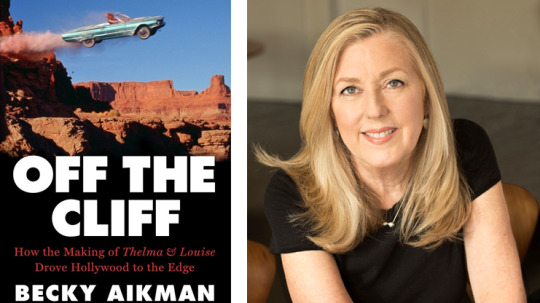
When Callie Khouri wrote Thelma & Louise in 1989, she was a newcomer. Callie worked behind the scenes of music videos, and the story she decided to tell, about women who become increasingly free, was in part a response to what she saw every day at work: hypersexualixed women serving as background for men, always men. Because she was a novice, perhaps she didn’t really understand just how much everything she was doing with her script went against Hollywood’s standards at the time.
More than two decades later, Becky Aikman reveals in which context Callie, with a lot of effort, managed to sell her story and see it on the big screen. At the time, action movies were topping the box office; and action, Aikman explains, meant men with guns. Women’s Pictures -- smaller movies focused on the interior lives of the characters -- were left for television. In the movies, more than the majority of speaking roles were male, and female roles were often limiting and archetypical. Women accounted for an average of 20 percent of movie crews. Of the top fifty movies of 1988, only two were written by women without male partners. The last time a woman had won an Oscar for best original screenplay by herself was 1932. The idea of Callie not only writing but also directing a movie as risky as Thelma & Louise -- as she had initially planned -- was absurd.
But why was Thelma and Louise’s story so risky, after all? Aikman chose Off the Cliff as the title of her book in a reference to the final scene of the movie, in which Thelma and Louise find themselves surrounded by police cars and decide to keep on running by literally throwing themselves off a cliff right there in the Grand Canyon. It was too much. It was too much to end in suicide a movie that already strayed so much from the expectations of the audience. An average of five movies, out of the fifty most successful per year, had female leads. Two female leads? Less than two movies per year. As a rule, men acted, women reacted (to them). Aikman reports that Geena Davis, who would be cast as Thelma, used to call many of the roles available for women the “good luck, honey!” characters -- the role left for the woman was, after all, to say goodbye when the man went on to live his adventures. Throughout the entirety of the casting process Geena’s agent would call the people in charge every week to let them know she was interested in playing either Thelma or Louise. Just like several other actresses.
But Thelma & Louise wasn’t simply a movie with female leads. Thelma and Louise were female leads living in a world where every man was nothing more than an archetype. They were women who escaped failed relationships and did things that female characters were never supposed to do: killing (once, a rapist, and feeling as conscious of their mistake as remorseful), stealing, running from the police, having sex with strangers, setting fire to a truck. They were women who became increasingly free and distanced from the standards imposed on female characters -- because of course men could kill, steal, run from the police, have sex with strangers and set fire to whatever they wanted without anyone screaming in horror that they weren’t good role models.

The obligation of being a role model is the burden the female character must carry. Recently, when Gone Girl, a thriller with an extremely cold and calculating female lead, was adapted to the big screen, a similar discussion took place. These characters’ enormous flaws are always pinpointed and their stories’ feminism -- or lack of it -- is always questioned, even if none of them have claimed to be feminist icons. Though for a good while anti-heroes were the norm when we thought about prestige TV, though even our most positive super-heroes now have dark undertones, it’s harder to sell a movie led by women who aren’t good role models. When we defend these stories, we’re not stating that these characters should represent every woman or that their actions inspire us. What we ask is for female characters to be allowed to be as good, or as bad, or as gray, as any male character -- without anyone wanting to ban them from theaters. What we want is to see as many female characters as there are women; back in 2014, though, when Amy Dunne was on the big screen, women comprised 12% of protagonists. In such a context, having a female lead is always a huge responsibility.
Aikman reports that seeing female characters in nontraditional roles was one of the things that pleased preview audiences. Over time, the movie became very meaningful to many women -- not because they closed their eyes to a murder that wasn’t executed in self-defense, but because of what the characters represented beyond their actions:
“But for the women who loved Thelma and Louise, it was not so much about what those characters did as about what they were: women living their lives in the movies for all to see. Women who looked like real women and talked like real women, women who had more on their minds than ‘Good luck, honey!’ Women who could laugh in the open about the at the too-recognizable foibles of men -- and women, too. Who understood what it meant to become that third thing when they were together, making choices -- even bad ones -- on their own.”
Thelma and Louise become so independent and start living so far out of what was socially imposed on them that Callie saw the falling-off-the-cliff ending as their only way out. She didn’t consider it tragic, or even suicide: “Women who are completely free from all the shackles that restrain them have no place in this world. The world is not big enough to support them,” she would state later. It wasn’t tragic because art is able to represent situations that are meaningful in ways that go beyond the literality of life. “They flew away, out of this world”, Callie said, “and into the mass unconscious.”
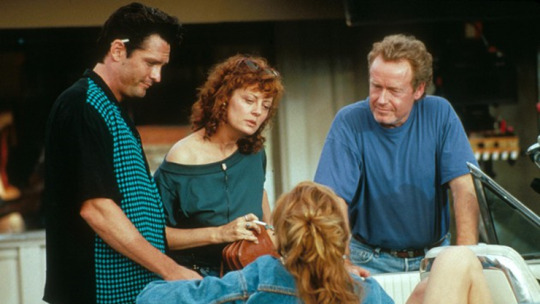
With many difficulties and some creative differences between Callie Khouri and Ridley Scott, for the most part it was her singular vision that was followed. But Thelma & Louise didn’t change cinema. Aikman quotes Geena Davis discussing the widespread assumption that the film’s success would open new roads for women and their stories. The same happened with the success of A League of their Own, another movie starring Geena which defied conventional gender roles. But they were both isolated phenomena in a deeply sexist industry. After years of being both a witness and a victim of the industry’s sexism, Geena founded her own research institute to discuss the way women are being represented in the media -- and the results are usually not very positive. Aikman explains that the many recent blockbusters with female leads are still seen, again and again, as anomalies by the studios. Men continue to be their safe bet.
For those who follow the discussion about women and the media closely, many of the facts, stories and numbers that Becky Aikman uses to contextualize the story will seem like old acquaintances rather than a novelty. But she makes very good use of them, linking the information with the story she tells, in much detail, about one of these Hollywood “anomalies” that are impossible to ignore. Her writing is accessible and captivating and reading the book, which combines the main storyline with Aikman’s own observations about the bigger issue of women and film and with what the many people involved in the production of Thelma & Louise thought or think about it, is an enjoyable and enriching experience. Above all else, I like that Aikman is not afraid of expressing her opinions and pointing out the double standards for men and women in the industry or the excuses Hollywood uses to keep on treating our stories as a niche interest.
Thelma & Louise didn’t change cinema, but,as Aikman points out, for a moment it drove Hollywood to the edge of a cliff that the industry is still afraid of facing. Beyond it rests a world of stories waiting to be told. Callie Khouri told one of them, and the result was a movie that is now part of the collective unconscious -- exactly what she had envisioned for Thelma and Louise’s final choice.
We received the book from Penguin Press in exchange for a review.
About the author
FERNANDA
Officially a translator and proofreader, Fernanda has a special love for literature and for this writing thing. A loyal follower of the uncool lifestyle, she doesn’t believe in guilty pleasures nor in the concept of liking something ironically.
Art by Carol Nazatto
This piece was originally published in Portuguese on June 27th, 2017, on Valkirias.com.br Translated by the author.
#thelma & louise#off the cliff#feminism#geena davis#susan sarandon#callie khouri#becky aikman#penguin press#category:film#category:literature#author:fernanda#translator:fernanda
5 notes
·
View notes
Text
A Game of Inches: Part 1 (A Hannigram Super Bowl AU)
Many thanks to @the-winnowing-wind, @confusedkayt and @cannibalhouse for being with me Sunday night as I slowly unraveled during the most insane Super Bowl ever. Of all time. Jesus Christ. Seriously. But by the grace of Fannibal magic, many hugs, and judgmental leopards did I not die of a heart attack during that fourth quarter.
As promised and witnessed by the football gods who saw fit to bless the Pats with the most absurd comeback in Super Bowl history, here is part one of my fourth quarter sacrificial offering: a Hannigram football AU lifted directly from the game. Some liberties were taken with the game clock, but both of these absurd plays actually happened Sunday night. Thus they shall be honored before we get to the victory smooches. Post game smut and riffing on the hilarity that is football commentary to come with such lines as “Wow! He saw that hole and certainly took advantage of it! What a tight fit!” Get excited, y’all.
Now, I am proud to introduce to you, your very own Baltimore Ravenstags, Hannibal fandom!
(Who maaaaaaaaaay or may not closely resemble another team elsewhere on the northeast coast. Mwhahaha.)
It had been a punishing three quarters, an apparent disaster to the naked eye. 9-28. The Minnesota Shrikes still leading. It was an unprecedented deficit to overcome on the largest stage of a player’s career, but the mood on the Ravenstags sideline was shockingly calm because of him…because that’s who he was. As bleak as the scoreboard looked, there was never any doubt who had controlled the time of possession in this game. If just a few more plays had gone their way, it would be an entirely different story right now. For the Ravenstags, it was a question of momentum.
Hannibal Lecter stood on the sideline glaring down the opposing offense with his hands on his hips and murder in his eyes. His jaw was relaxed and his shoulders loose like he didn’t care how much time was left. But Will, who knew the quarterback better and more intimately than anyone else on the team, could see the small signs of distress–the little chinks in the armor that could spell disaster for the team. Hannibal had ceased bothering with his sweat drenched bangs which fell into this eyes. The tilt of his hips also betrayed a slight favoring of his right leg, a reminder of the nearly career ending injury that had taken him out of the 2008 season. These things worried Will. The opposing defense would soon see them too, and next, Hannibal would begin seeing ghosts on his bad side. Errant passes into triple coverage would follow if the tone of the game didn’t change soon.
But Will had to disguise these feelings and bury his empathy on the sideline because when you were Hannibal Lecter’s knife there were as many eyes were on you as they were on him. It was an inevitability, and one that Will resented because it interfered with his ability to look after the man beneath the legacy.
The Shrikes called a timeout on a crucial third down to confer with their defensive coordinator. On the Ravenstag sideline, Coach Du Maurier slid up to Hannibal’s side and tugged on the sleeve of his jersey. They exchanged a few words and turned as one unit towards Will.
He swallowed as Hannibal beckoned him over with a hooked finger and an even more lopsided smile, which was never a good sign. Hannibal and Coach Du Maurier were cut from the same cloth: genius strategists with a flair for the dramatic. Their unorthodox play calling allowed them to dominate the League year after year. They had confounded defenses and analysts alike through four championship runs together and seven total Super Bowl appearances.
“What’s the angle?” Will asked because he could only assume that they were reaching into Bedelia Du Maurier’s infinite bag of tricks wearing smiles like that.
“Clarke Kent,” Coach answered eliciting a groan from Will. The situation was as desperate as all that? Yikes!
“Come now, Clarke,” Hannibal laughed and rested his hand on Will’s hip. “You flew so well the last time.” This was a ridiculously hammy way of referencing the now infamous trick play that made use of Will’s experience as a college quarterback at Kent State.
“I think you just want to wreck my QB rating, Lois.” Will gripped. “Mine is still at 100%. What’s yours again, grandpa? 97?”
Hannibal’s honey-colored eyes narrowed dangerously in response to his least favorite insult, but a sudden commotion on the field tore his attention away before Will could regret his choice of words. Their defense had stopped the Shrikes advance and now, it was ‘go time’.
“I’ll get us to the fifty! Be ready!” Hannibal shouted amidst the flurry of activity as the Ravenstags defense came off the field.
“Don’t screw this up, you twitchy little man.” Coach Du Maurier warned and pinched Will on the ass for good measure.
The Ravenstags switched to an uptempo offense with Hannibal calling the plays from the line of scrimmage instead of from a huddle in order to wear down the defense and save precious time. Hannibal diligently marched the team to the fifty yard line and called the risky play. “Clarke! Clarke! Fifty one is the mike!” he screamed signally to the offense where he saw a problem developing on the defense. Two seconds of nerve-wracking scrambling occurred on both sides of the line. It was a third down now. They only had one shot at this.
The snap was called. Will dropped back to catch the lateral pass from Hannibal.
Time slowed as it always did when he practiced this play. Being a receiver required a different mindset than that of a quarterback, but it was a mindset Will understood having been one himself in his youth. Will detached from himself. He detached from the defenders that were hurtling towards him. He detached from the hopelessness of their circumstances. To be a good quarterback you needed to create a reality where only you and the field existed. He went through his progressions and saw Jimmy gaining some separation from the cornerback that was assigned to him. Will stepped back, visualized the moment when the ball would leaves his hands, and threw it. His movements were instinctual because no matter how far he’d come in his career as a wide receiver there would always be some part of him that was still a quarterback. He’d never win any awards for aesthetics. He was not like Hannibal, but they understood each other. For both men, football was a blood sport, but Will’s ethos was about utility and lethality.
He watched the ball arc through the air with bated breath. It had a good spiral on it, and Hannibal would not be able to give him lecture on his throwing motion tonight. But downfield, Jimmy had fallen behind. The ball bounced off his fingers ending another fruitless offensive drive for the Ravenstags.
Will ripped off his helmet and spiked it onto the ground “Dammit!” he screamed and looked for Hannibal, but Hannibal had already left the field.
Dejectedly, Will picked up his equipment and trudged back to the sideline. Hannibal sat on a bench with his head bent over a tablet in conversation with Coach Du Maurier. Will’s standard place at Hannibal’s side was left open for him and he could think of no excuse to avoid it. Will plopped down, stared at his feet, and considered whether he should apologize or not for not being good enough. But he worried about the cameras. It would be disastrous to be picked up on the jumbo-tron groveling for approval from his lover. The rookies needed their generals to be strong.
Will grabbed a bottle of Gatorade from a passing waterboy and shifted on the bench so his knee touched Hannibal’s. ’I’m sorry,’ the gesture said when words could not be spoken.
Hannibal never broke character, but he widened the spread of his legs so that their thighs touched. ‘I know.’
A cheer went up when the Shrikes quarterback came onto the field at the moment Will felt at his lowest. Cheers that rightfully should belong to Hannibal in his opinion. At thirty-nine, Hannibal was a better player than he was a decade ago. A four time Super Bowl Champion; three time MVP; Hannibal had more wins than any other quarterback in history. But Hannibal was also Hannibal, and frankly, he was kind of a dick in addition to be entirely unrelatable being both an art snob and actual nobility.
‘I WILL do better,’ Will vowed. He looked up into the the bright stadium lights, and let the noise inside. The discordant melody filled him, and he transformed those cheers into anger. When he got up off the bench after another critical stop by the Ravenstags defense, Will Graham was ready to kill.
A penalty gave the Ravenstags a much needed first down, but Hannibal slowed the tempo to a crawl by calling the team to the huddle. It was a suspiciously cautious move with ten minutes left on the game clock. “Will, I want you to dart up the middle. Get out fast and get ahead quickly. If you draw double coverage, Z should have an opportunity on a outside.”
“I want the ball,” Will growled getting a laugh from the other ten men.
“You always want the ball,” Hannibal smiled. “Let Z have it this time, pet. Does everyone understand their assignments?”
Will glared at Zeller, the other slot receiver on the team, and gave him his best ‘don’t you dare drop it because I will murder you’ look. There was admittedly a bit of a rivalry between them since Zeller had tried to steal Will’s locker besides Hannibal’s during Zeller’s first season on the team.
“Adapt! Evolve! Become!” The team shouted as one to break up the huddle and affirm that they understood. The ball was snapped. Will ran his route flawlessly drawing three defenders instead of two but felt a prick at the nape of his neck alerting him to danger. Will looked over his shoulder and saw with horror that Zeller had gotten stuck in the box while the pocket of protection collapsed around Hannibal.
He saw Hannibal’s eyes searching desperately for an opening. This was it. This was the nightmare scenario. Will had only a second to adjust knowing full well what was coming next. Will twisted on the balls of his feet changing the direction of his forward progress. He dropped his right heel into the Astroturf at the exact moment Hannibal’s eyes locked onto his. Will pushed himself forward as the ball left Hannibal’s hands. He reached as far as his arms could stretch and felt the impact of three defenders crashing into him.
The ball was tipped by a defender before Will reached it. He knew with absolute certainty it would just miss his hands and fall instead into the outstretched arms of the safety for a devastating interception to end any chance the Ravenstags had of recovering this game. The emotional despair Will felt was more crushing than the physical weight bearing him down to ground, but the winds of fate suddenly shifted. Miraculously, the ball bounced off the ankle of Nicholas Boyle. It hovered in midair, six inches off the ground, and somehow, Will managed to get his hands beneath it before it touched the turf.
The instant Will had his hands on the pigskin, he reeled the ball into his chest and curled up around it at the bottom of a dog pile. The Shrikes grappled with him for the ball hoping to knock it out of his hands before he had full control of it, but Will held onto the rock as if his life depended on it.
His teammates eventually pulled him out from underneath the pile. There was hugging and shouting and signs of life on the Ravenstag offense. Will gave the ball to a lineman and risked a brief glance at the uprights not wanting to get his hopes up. Forty yards to go and another four downs to do it in. They still had a chance! Christ. The Ravenstags were a wink and a nod away from the red zone now after the most improbable catch of Will’s career. It just didn’t seem real.
“Will.”
Will turned towards the sound of the one voice he knew better than all others. Even at a whisper, Will could always pick out Hannibal’s voice above the roar of the stadium. His quarterback came towards him wearing a look of shock and reverie. It was a face Will loved to see in the privacy of a hotel room or their Baltimore home, but it was not appropriate now–not when they had everything to win!
Will ran at Hannibal at top speed and grabbed him by the face mask. “I told you!!! What did I tell you!?! Give me the damn ball, and I’ll bring the whole damn world to its knees for you!” he shouted into Hannibal’s face and brought their helmets crashing together.
Hannibal looked dazed at the receiving end of a Will Graham headbutt, and that served him right. Will had acquired the habit from him after all. The violence did its job, and brought Hannibal back into himself. Will saw the competitive fire reignite in his eyes, and his heart swelled with affection and pride for his quarterback.
“Let’s kill them all, Will.” Hannibal said. He pushed Will away and slapped him on the ass as Will trotted past.
Will raised his voice and howled with the thrill of the hunt. Adapt. Evolve. Become. That was the Ravenstag way. “Let the game begin!” we shouted defiantly at the deafening roar of the mob.
For context, here is what these two plays actually looked like in real life for anyone curious. Numbers 12 (Hannibal - Tom Brady) and 11 (Will - Julian Edelman) are the players you want to watch.
Clarke Kent: I wasn’t able to find video of it from last night’s game, but here, watch the time it actually worked. (It’s better this way :p) Edelman really is a former QB from Kent State. I don’t know what the actual play is called, but a pun seemed appropriate for our boys. This is also my favorite play in the Patriots’s playbook so I wanted to share. I’ve been writing “Edelman has to QB for various reasons” fic long before it ever happened in a game. Seeing it last night was just “AHHH! *hearteyes*” even if it didn’t work out as hoped for.
The Catch: JESUS H. CHRIST! Mother fucking triple coverage! I don’t know how he did it. In the game last night, the play came after the pats had closed the gap to 20-28, but I didn’t want this piece to get too long or technical for the non-sports fans.
Anyway, thanks for humoring me. Part two will be less sports ball and more fucking. I hope you enjoyed this presentation of the NFFL - National Fannibal Football League. ;-)
21 notes
·
View notes
Text
Nick Cvijovic’s Top 10 of 2017
Nick Cvijovic slings guitar in Chicago punk band, Butchered.
I always love the end of the year because every media publication puts out their top-whatevers for songs, albums, movies, etc. The problem I face every year is that I get super attached to albums that came out the year prior and then tend not listen to anything new throughout the year until the next best-of lists come out. It’s a ridiculous cycle that I am glad to have broken this year. While most of my top listens were all 2016 albums, I did make time for stuff that came out this year. Just a short disclaimer: it is unanimously decided that Damn. by Kendrick Lamar was the best record of 2017.

I believe it is and everyone should believe it to be as well. It was an incredible work of art both in order and in reverse; however, my list does not contain it. My list represents the albums that meant the most to me throughout 2017 and albums that I will consider classics until the end of music. I played these albums endless amounts of times over the past year so I know what I like, I think. I whittled this list down from 35 different albums that I deemed my favorite and I still think ten albums is far too little to rank after this year’s offering of music. Whatever, here I go anyway…
10. Pulled Apart By Horses- The Haze // Mobina Galore- Feeling Disconnected

(Alright, I already have a tie, big deal.) Pulled Apart by Horses is a heavy garage-y band that brings so much more than your standard Ty Segall or whatever the flavor-of-the-week garage bands are in nowadays. The Haze is a perfect bar brawl soundtrack that reminds me of those early revival bands like The Libertines and the Fratellis, albeit with more fuzz. That’s what makes this record so good; there are tons of catchy melodies, great musicianship, and a liberal use of fuzzy guitar. It’s a simple formula that makes this album so much fun.
[Recommended track: “Hotel Motivation”]
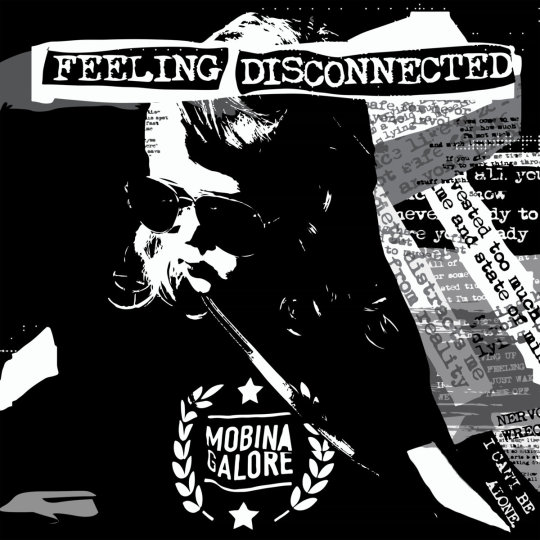
Also tied with this record is Winnipeg’s Mobina Galore, who put out Feeling Disconnected, the duo’s debut album. I couldn’t believe these girls were a two-piece when I first listened. The songwriting is incredible and is perfect fare for any punk, but also has a hardcore vibe. These girls blew up too after this album, and deservedly so; touring with the likes of Against Me! and Propaghandi- both bands that are clear influences on Mobina Galore.
[Recommended track: “Vancouver”]
9. Zeal & Ardor- Devil is Fine
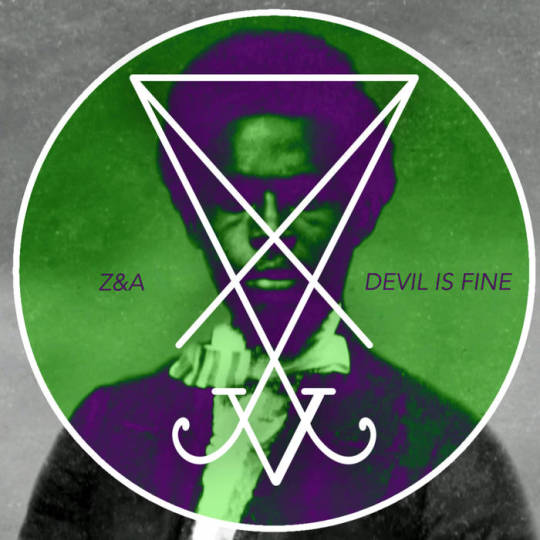
I’m going to quickly preface this by saying that I could have sworn this album came out in 2016 but Spotify says 2017 so screw it. Anyway, this album is the only good thing to ever come out of 4chan. Manuel Gagneux is a Swiss-American musician who came to New York after fleeing his Swiss Army duties and decided to ask the cesspool of 4chan what kind of album to make. They responded to his request by saying black metal and the blues, although not in those words because it’s 4chan. Gagneux’s debut as Zeal & Ardor takes black metal’s typically buzz saw guitar and pairs it with his own rendition of Satan-worshipping delta blues chants. It’s seriously the most original metal offering that I can think of, becoming almost hypnotic during the call and response verses channeling old slave songs of the mid 1800s and then ripping your stupid head clean off when the screaming and instrumentation kick in, and then become almost danceable when the two are blended. I don’t know, I get too excited talking about this record, and there’s so much to dissect within it. While sticking to blues-inflected black metal, there is also lounge and EDM styled songs which break up the record wonderfully. It’s all so cool, dudes. [Recommended track: “Come On Down” ]
8. The Dopamines- Tales of Interest
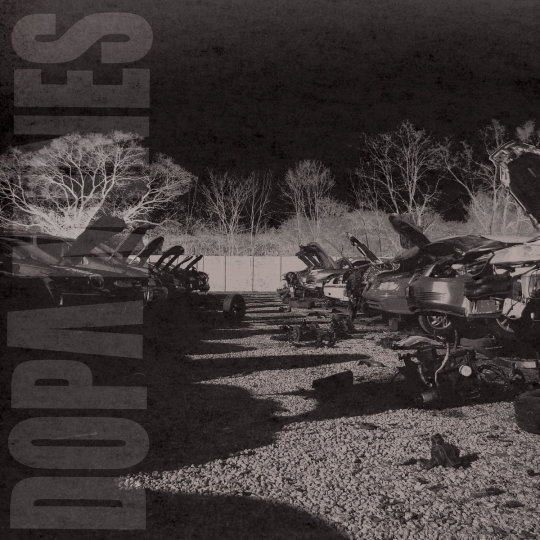
I am a sucker for self-deprecating punk rock and Cincinnati’s The Dopamines have always done it the best since their debut in 2008. Nine years later they are still screaming about their jobs and being broke; typical punk rock themes. But they have great harmony and melody within every seemingly-three-chord song that really separates them from every other band within their genre. Tales of Interest is full of songs that are believable; what I mean is that there is so much feeling in every note, chord, and lyric that it never ever gets whiny. Couple that with the Dopamines ability to have awesome songwriting that can rip on one chord over and over without ever getting tiresome and you have a perfect Midwest punk record. The dudes also incorporate some super heavy metal riffing on a few of the tracks which makes this album the best for getting too drunk and yelling at the top of your lungs until your neighbors call the cops. Stupid neighbors, they’ll never understand. [Recommended tracks: “Ire” and “Kaltes Ende”] https://radgirlfriendrecords.bandcamp.com/track/ire-2
7. Woe- Hope Attrition

I had the hardest time trying to decide to put Power Trip’s incredible Nightmare Logic or Bell Witch’s Mirror Reaper in this spot because both of those albums were very important this year, not just in metal, but in the mainstream as well. Hell, Pitchfork loved both. Well, the mainstream’s opinions are crap and Woe had the best metal record, and nobody was really talking about it. Hope Attrition came to my attention only a few weeks ago but I think I have listened to it once or twice a day since then. Black metal seems to be pretty repetitive stylistically recently (shoooooeeeeegggaaazzzeeee), but Woe brings an album that is equal parts epic and brutal. Sure, there are blast beats and guttural vocals, but Hope Attrition also throws in some high pitched screams, clean vocals, and interesting song structure. The guitars fucking wail too, and feature some of the coolest sounding solos I have heard in a long time. This album differs from a lot of black metal lyrically too, singing about real life evils of white supremacy and our nation’s ineptitude. It’s refreshing (for me at least) to have metal be topical, and to lean more leftist. None of it matters anyway because you think Mirror Reaper should have been on here. Shove it. [Recommended track: “No Blood Has Honor”]
6. Rozwell Kid- Precious Art

One of the lines that begins this album states, “I’m down to my underwear because I through it all away in a Wendy’s trash can” and if you don’t think that is the best damn line ever than you are a moron. Rozwell Kid continues in the tradition of making guitar rock awesome again, essentially making a record that Weezer should be doing, but would get shit on for because it’d still be too weird for them. Precious Art’s themes are personal, but filtered through wit and loud dueling guitars. Songs thematically range from losing it, to romantic hangs watching UHF, to a song about wanting to be something else- specifically a dog. Everything Rozwell Kid does is a lot nerdy, a lot sarcastic, or a lot goofy, to veil deeply emotional writing but they never fail to keep the guitars loud as hell. [Recommended track: “Wendy’s Trash Can”]
5. The Eradicator- The Eradicator

The first time I ever saw the Eradicator live was when he opened for Direct Hit! at the Double Door for the Wasted Mind release show. I had seen the sketch before (the Kids in the Hall sketch) and was incredibly excited to hear how one guy was going to base an entire set of songs off of one or two 5 minute sketches from an old TV show. The sketch is about a masked squash player trying to work up the ranks of his local D-squash league. He eats, breathes, and sleeps Squash, and the Eradicator embodies everything that this character was. I found out soon that not only are the songs hilarious, but they also shred. The Eradicator can get everyone in the crowd, even if it’s their first time hearing him, to sing along to songs about his quest to climb the D-squash ladder. The songwriting features a mix of straight forward punk rock to hardcore bashing but always stay to true to reminding the listener that football sucks, tennis sucks, baseball’s cool, curling rules, but they’re not the sports for him. [Recommended track: “I’m a Squash Man”]
4. Metz- Strange Peace

What would any list of best albums be if it didn’t include Canada’s finest? A list not worth publishing that’s for sure. I was so worried that Metz would fall into a hole of making a softer sounding indie rock album, similar to Cloud Nothings new record, but am I glad that I was wrong. Also, of course they wouldn’t do that; they’re one of the loudest and most raucous bands around. Strange Peace is filled with wall to wall bangers, some coming in under a minute and some almost pushing the six minute mark. This record is sort of similar to their other albums, and that is what makes it great. Metz doesn’t need to change up their sound too much to keep any listener happy; they stick with the incredible drumming, thundering bass, noisy guitar work, and catchy yet screaming vocals.
[Recommended track: “Mr. Plague”]
3. IDLES- Brutalism

I got turned on to IDLES from one of my students, actually. Upon first listen, I was like, “what is this?” It was so out there from my normal tastes that I couldn’t stop listening. IDLES fills this album with simplistic musicality, akin to Plague Vendor or Protomartyr, but it’s in the vocals and song writing that really caught me. The songs on Brutalism are a collection of working class angst and sarcastic commentary on pop culture all almost spoken, rather than sung. That does not take away from the catchiness of it, though. All the songs clearly come from the heart and are brutally honest, anthems for those who are dissatisfied and bored as hell. I’d pair this record with whiskey and percosets at 8am after being laid off from your shitty job. [Recommended track: “Mother”]
2. Japandroids- Near To The Wild Heart of Life

Japandroids has been one my favorite bands for a long time. I absolutely love how incredibly huge their sound is for being a two-piece, although with a butt load of amps. Japandroids had been relatively silent since their last album, Celebration Rock, which came out in 2012 to great reception. Everyone was fairly skeptical if they could repeat the anthems and sing-alongs that that album brought, but they totally blew everyone out of the water. This album may seem just like a regular rock album to some, but the songs are just so perfect to blast whether you’re having a bad day, a great day, alone, with friends, drinking, hungover, whatever. I can’t help but get chills when this album comes on; the dynamics are amazing and make you feel alive. If there was any single record that 2017 needed to feel better about itself, it’s Near To The Wild Heart of Life. [Recommended track: “In a Body Like a Grave”]
1. ’68- Two Parts Viper

Josh Scogin is the best vocalist in hardcore; hands down. When his last band, hardcore heroes The Chariot, broke up, I was so disappointed that we wouldn’t have any new music from him in the future. Then ’68 dropped two tracks in 2014, followed by one of the most awesome albums ever, In Humor and Sadness. ’68 keeps with their untouchable blend of hardcore and rock and roll on Two Parts Viper, a sort of combination of The Chariots spastic riffs and songwriting, and White Stripes-styled two-piece heavy blues. Scogin’s lyrics really shine through on this album as well, coming off as spoken word at parts before the crushing guitar and drums bash in. Where there’s feedback on this album, there is Scogin’s poetry; where there is screaming, there is singing. This is one of the most dynamic records to come out in a long time, going back and forth from heavy rock-oriented riffs and grooves to chanting and Josh’s inimitable screaming, even throwing in the oddball sample in the middle of a song. There is nothing that comes close to ’68 in terms of style and I don’t think there ever will be. 10 out 10 snakes.
[Recommended track: “Whether Terrified or Unafraid”]
1 note
·
View note
Text
Giancarlo Stanton’s breakthrough season through the eyes of those witnessing it
Giancarlo Stanton has hit 56 home runs off 48 pitchers in 13 major league parks this season. Those homers have traveled a combined distance of 4.42 miles at an average exit velocity of 108.9 mph, second highest in the majors behind New York Yankees outfielder Aaron Judge.
No one has kept a running statistical tab of Stanton’s batting practice output. But if a ball off Stanton’s bat dents a bleacher seat somewhere between 4:30 and 6 p.m., chances are Fredi Gonzalez delivered it. The Miami Marlins’ third-base coach is Stanton’s regular batting practice pitcher, and he keeps a mental catalogue of the screamers Stanton hits up the middle.
Each time one of those line drives approaches his face, Gonzalez gives a silent thank you to the inventor of the “L” screen.
“If I go a little bit away, I know that ball is coming my way,” Gonzalez said. “There have been 30 or 40 times when I’ve never seen the ball hit. The first time I see it is when it hits the ground off the screen. I’ve felt it come close. And then — whoomp! — it’s right there.
“He hasn’t knocked the screen over yet. He’s not that cartoonish. But if I was a pitcher, I would be scared.”
Major league hitters have done plenty of yard work in 2017, hitting an astounding 5,707 homers so far this season. We look at who hit ’em, when they hit ’em and how many they hit.
Stanton has already joined Ryan Howard of the 2006 Philadelphia Phillies (58), Jose Bautista of the 2010 Toronto Blue Jays (54) and Chris Davis of the 2013 Baltimore Orioles (53) as the fourth hitter in the past 12 years to crack the 50-homer mark. His output has slowed since he tied Rudy York’s MLB record with 18 homers in August — but if he can crank out another 2,000 feet worth of long balls in the coming week, things will get very interesting on the final weekend of the regular season.
Stanton needs five home runs to tie the total of 61 by Roger Maris that stood as the MLB record until Mark McGwire, Sammy Sosa, Barry Bonds and the PED era came along. He has emerged as an MVP candidate while playing for a Marlins team that’s 72-80, 28th in baseball in attendance, and in the news primarily because the franchise is in the process of being sold from Jeffrey Loria to a group headlined by Derek Jeter. Stanton has also reignited divisions between baseball watchers who regard Bonds’ single-season total of 73 homers as the MLB gold standard, and purists who view Maris’ 61 as the legitimate, untarnished record.
What has it been like to watch a masher of Stanton’s magnitude up close and personal, from the dugout and the clubhouse? How has Stanton grown since his MLB debut as a 20-year-old man-child in 2010? ESPN.com talked to the Marlins teammates, coaches, front-office staff and broadcasters who know him best for their thoughts on Stanton’s memorable season and budding legacy.
The batting practice showOpponents regularly come out to watch Giancarlo Stanton in batting practice. Photo by Tony Quinn/Icon Sportswire
Brian Schneider, Marlins catching coach:
“I like it when he’s taking batting practice and the other team comes out specifically to watch him. It’s September and you have a lot of the call-ups, and guys come out early. The last time we played the Phillies, there were seven or eight guys out there early watching him in amazement. Their reaction was like our reaction watching him every day. It’s crazy how far he hits it.”
Fredi Gonzalez, Miami third-base coach:
“Ichiro has been in his group for the last month and a half. It’s Stanton, Ichiro, Miguel Rojas and J.T. Realmuto — or A.J. Ellis when J.T. doesn’t play.
“When Ichiro is in his group, they play a game where it’s 3-2, bases loaded. A home run counts as four runs. Ichiro has some juice, and one day he had an immaculate round. He had four home runs on four pitches. Stanton hit only three out, and Ichiro beat him.
“Usually he stays in the middle of the diamond and he’ll hit balls to straightaway center. But that’s the only time you’ll see him get competitive and go a little extra. That’s the only time I’ve seen him try to play Home Run Derby.”
The home runs you just can’t forgetGiancarlo Stanton’s homers have traveled a combined distance of 4.42 miles at an average exit velocity of 108.9 mph. Scott Cunningham/Getty Images
Catcher A.J. Ellis:
“We played a series against the Rangers this year, and Jason Grilli was pitching. He pitches with a lot of intensity and emotion, and he struck out Giancarlo and gave a very dramatic fist pump and yell after he put him away.
“You could see from the way Giancarlo reacted coming off the field that he didn’t really appreciate that. So in a rare outburst of emotion, the next day ‘G’ hit a home run off Grilli. He usually acts the same way on every single one. There’s no bat flipping, no extracurriculars after he hits them. But on this one in particular, he gave a yell and threw his arms up in the air. You could tell that one felt pretty good.”
Center fielder Christian Yelich:
“My favorite homer of his came against the Cubs and Jason Hammel [on June 16, 2014] at Marlins Park. It was a line drive down the right-field line on a curveball in the lefty batter’s box. He’s probably the only guy in baseball that can do that. That skill set is not something you see every day — just being able to hit the ball that hard and being that strong.
“Everybody can hit balls far. The line drives, to me, are the more impressive ones. For most guys, that ball might be a single or a double. He hit it for a homer.”
First baseman Justin Bour:
“I’ve seen a million of his homers by now and I’ve watched him in BP, but I’ve never seen anything like that one [off Hammel]. I’m pretty sure the first baseman jumped for it and the ball went out. You have the right fielder out there thinking he’s going to make a play off the wall or field a one-hopper. You’re thinking double off the bat or maybe even a single because he hit it that hard, and it went over the fence. There are so many to pick from. But you don’t see people hitting low liners out to right field like that. It was the most amazing thing I’ve ever seen on a baseball field.”
Fredi Gonzalez:
“I bet you of the 55 he’s hit, I’ve seen maybe 15 of them actually land. Because as soon as he hits them, you know they’re gone. By the sound and the angle, you know they’re gone. Then I just watch the third baseman and shortstop look at each other like, ‘Did you see that?’
“He hit one in Atlanta to straightway center and [Braves third baseman] Rio Ruiz looked at me and went, ‘Wow!’ [Phillies third baseman] Maikel Franco had an expression that was like, ‘Holy cow. I’m glad he didn’t hit it on the ground.'”
Dave Van Horne, veteran broadcaster and Glenn Geffner’s radio partner in Miami:
“When Stanton first started to hit these tape-measure jobs, we had never seen anything like it. One day in Denver, Geff and I walked out to the concourse, out to that food area, to find the spot where one of his home run balls landed. I had never seen anything, even at Coors, hit that far. And the amazing thing to me about Stanton is, he doesn’t hit any wall-scrapers. There’s nothing coming down on the back of the wall. Ninety percent of them seem to be absolute no-doubters.”
Pitcher Dan Straily:
“You don’t want to be anywhere but in the dugout for his at-bats. Every time he comes to the plate, it’s captivating and you don’t want to miss something awesome. You don’t want to miss a ball leaving the stadium. With so many of the balls he hits, you’re like, ‘I’ve never seen a ball hit that far.’ It’s a fun at-bat to watch, every time it comes back around.”
The evolution of GiancarloGiancarlo Stanton worked with the Marlins’ hitting coach to close up his stance this season. Patrick McDermott-USA TODAY Sports
Tony Perez, Baseball Hall of Famer and a Marlins special assistant:
“I saw him when he was in Double-A ball and he won a home run contest. He hit the ball all over the place. I was there with Andre Dawson and I told him, ‘Pack it up, let’s go home.’ I said, ‘Wow, he’s something special.’
“Now he’s grown up and he’s changed. He’s more disciplined, and when he hits a streak, he’s dangerous. I used to see Gary Sheffield hit unbelievable line drives and Willie Stargell hit those long home runs, but this guy is amazing the way he hits.
“In the beginning, he wanted to do everything himself. He was his own man. He believed in himself a lot and he didn’t listen. Then this year he changed his stance. He closed up a little bit because he was wide-open and swinging at everything. He found himself working with the hitting coach [Mike Pagliarulo] and his assistant [Frank Menechino], and they’ve helped him a lot.”
Manager Don Mattingly:
“One thing I’ve noticed this year is, he’s more focused and irritated with himself over his at-bats when they’re not good. You can feel the helmet [slamming] behind you. I don’t really look around and see what guys are doing. But you hear it and you know when he’s mad about his at-bats. That’s been a little bit more open. I’ve seen him throw a bat down on the field, too, and I didn’t see a lot of that last year.
“He’s comfortable at the plate. This is the most I’ve seen him stay with something. I’ve seen him make a lot of changes in the past, with his hands, his feet, a toe tap and other little things. This little closed-off [stance] thing is something he’s really stayed with.
“He’s definitely not chasing as much. You still see some chase in there, but you see a lot more focus within an area of the plate. He’s making guys pay. He’ll miss some balls that he fouls back and you say, ‘He just missed that.’ But there was a section of the season when he wasn’t missing anything. It was like, ‘Holy cow, this is ridiculous.’ It’s something I’ve never seen.”
Straily on Stanton’s 14 first-inning home runs:
“He went through a stretch earlier this year where it seemed like he would ground out to shortstop the first at-bat every single at-bat. The guy was so frustrated, knowing he could get this [pitcher] and essentially he just missed. It sounds weird saying, ‘A ground ball to shortstop and he just missed.’ But with that guy, he clearly just missed. It was definitely the right angle and the right part of the field to use, and he’s used to hitting homers.
“Then suddenly he made an adjustment in his first at-bat of the game, and when he [got hot] a lot of his homers came in the first inning. It was cool to see how he saw an area of his game that he wasn’t elite at, and he was so focused every at-bat. He put a little more emphasis on that very first one, and those ground balls to shortstop started becoming homers.”
Fredi Gonzalez:
“I kind of joke with the guys. I told [Nationals third baseman] Anthony Rendon, ‘After he strikes out the first time, he usually lays a bunt down the second at-bat.’ Early in the year, [Mets third baseman] Wilmer Flores was playing back and Stanton hit a ground ball and it was a backhand. Flores couldn’t get the glove down fast enough and the ball hit him on the instep. I couldn’t stop laughing.
“You know what he also has? He has carry on his ball. There have been a few times when he hits one and we have runners on first and second, and I’m watching to see if the ball is off the wall or the warning track, and you see the outfielders and it keeps carrying and carrying. The next thing you know, it’s 10 rows deep. We have a saying in baseball, ‘It stays hit.’ Some guys hit the ball and it kind of dies in the gap. His ball stays hit.”
Facing StantonSome pitchers try to throw harder to beat Giancarlo Stanton, but that hasn’t proved to be an effective strategy. AP Photo/Jeff Roberson
Straily:
“Greg Maddux had a quote once. He said when he found himself in a tough situation, he didn’t try to throw harder. He tried to locate better. You see so many people try to muscle up on Giancarlo and end up leaving the ball over the heart of the plate. If you watch a guy who’s throwing 90 or 91, all of a sudden he’s throwing 94 against Giancarlo thinking that’s going to work.
“You’re better off trying to just locate it. If you take something off and you miss, it’s gonna get hammered just as hard. But you see people try with more effort, and you’re not going to be able to match his effort and his strength with his bat. Muscling up is not really the way to go.”
A.J. Ellis:
“I remember being on the other side. With Giancarlo, the way his at-bats are and his approach is, there are windows where you can pitch. So you go into the series as a catcher and a pitcher and say, ‘If we execute the ball to these places, to these windows, we’re gonna be successful and get this guy out.’ There’s a difference, though. Those window frames for him are home runs. For me and everyone else, they’re broken bat singles.
“If you’re not drilling those small windows — if you miss — you’re paying dearly for it. You see pitchers challenge him and try to hit certain spots. But there’s a lot of pressure on the mound, knowing mentally that if I miss, I’m going to have something hit extremely hard and extremely far off me.”
The lasting impressionGiancarlo Stanton seems to be motivated since the All-Star Game. Joe Skipper/Getty Images
Mike Berger, Marlins vice president and assistant general manager:
“I can’t get away from the charge that took place right after the All-Star Game. It seems like every home run he hit was impactful because it gave us an early lead in the first inning or it was a tack-on, 2-3-run homer. Just the frequency of the home runs. I’ve never seen anything like it.
“Aaron Judge won the Home Run Derby and Stanton was like, ‘Hey, Grasshopper, I’ll show you what I’m capable of as we come out of the break.’ Who knows if it motivated him? It may very well have. But it was a big deal, with everything that’s gone on with the uncertainty of the franchise and whatnot. I think he rose to the occasion and let his actions answer the question.
“We went from a Judge to a Supreme Court Justice. That’s kind of the way it was. [Aaron Judge] was an appellate judge and Stanton showed everybody that he’s a Supreme Court Justice.”
Dave Van Horne:
“The first time I saw Andre Dawson, I thought, ‘This is the best looking physique I’ve ever seen on a baseball player.’ Until this guy. Dawson was chiseled. He was slender and had zero body fat, but he had a massive upper body. Goodness knows what he would have done if he hadn’t hurt his knees playing football before he signed. He was an incredible athlete. But it was nothing like this guy.”
Berger:
“The way he embraced the whole All-Star week was impressive. He was the gracious celebrity All-Star host, and that’s what came through to me. There’s a lot of charm there. There’s a magnetic charisma, and it’s a Hollywood smile.
“I think the commercial he did for T-Mobile is fantastic, with the guy on the sidelines hammering him with nicknames. I even commented to my wife. I said, ‘You know what? He’s really natural at the give-and-take.’ Otherwise, he’s a pretty guarded dude who just does his work, but he was really natural there. A star was born with that 30-second give-and-take in that commercial.”
Van Horne:
“It’s 49 years for me, and in those 49 years, I’ve seen some pretty special players and a lot of Hall of Famers. I’ve never seen anything like this power display. I know that in his mind, 60 and 61 are the magic numbers, so it would really be something to see that. Plus, I was a child of that era, so those numbers are big for me, too.
“Let me put it this way: I totally understand why Stanton feels the way he does. And he’s not alone.
“I do five innings [of play-by-play] and Geff does four, but the one thing I like about my chances is, he’s hit more in the first inning (49) than any other inning in his career. I have the first two innings, so I might have a chance [to call it].
“I’ve seen Vladimir Guerrero. I saw Andre Dawson, obviously. Andres Galarraga, even Larry Walker. Guys that had really good long ball power, but nobody with the consistency of this player. And now he’s going to go through 2017 known as the major league home run leader. I’m sure it’s going to happen for him. To me, he’s a better overall player right now than he’s ever been.”
The post Giancarlo Stanton’s breakthrough season through the eyes of those witnessing it appeared first on Daily Star Sports.
from http://ift.tt/2xpB8cU from http://ift.tt/2yudDhA
0 notes
Text
Giancarlo Stanton’s breakthrough season through the eyes of those witnessing it
Giancarlo Stanton has hit 56 home runs off 48 pitchers in 13 major league parks this season. Those homers have traveled a combined distance of 4.42 miles at an average exit velocity of 108.9 mph, second highest in the majors behind New York Yankees outfielder Aaron Judge.
No one has kept a running statistical tab of Stanton’s batting practice output. But if a ball off Stanton’s bat dents a bleacher seat somewhere between 4:30 and 6 p.m., chances are Fredi Gonzalez delivered it. The Miami Marlins’ third-base coach is Stanton’s regular batting practice pitcher, and he keeps a mental catalogue of the screamers Stanton hits up the middle.
Each time one of those line drives approaches his face, Gonzalez gives a silent thank you to the inventor of the “L” screen.
“If I go a little bit away, I know that ball is coming my way,” Gonzalez said. “There have been 30 or 40 times when I’ve never seen the ball hit. The first time I see it is when it hits the ground off the screen. I’ve felt it come close. And then — whoomp! — it’s right there.
“He hasn’t knocked the screen over yet. He’s not that cartoonish. But if I was a pitcher, I would be scared.”
Major league hitters have done plenty of yard work in 2017, hitting an astounding 5,707 homers so far this season. We look at who hit ’em, when they hit ’em and how many they hit.
Stanton has already joined Ryan Howard of the 2006 Philadelphia Phillies (58), Jose Bautista of the 2010 Toronto Blue Jays (54) and Chris Davis of the 2013 Baltimore Orioles (53) as the fourth hitter in the past 12 years to crack the 50-homer mark. His output has slowed since he tied Rudy York’s MLB record with 18 homers in August — but if he can crank out another 2,000 feet worth of long balls in the coming week, things will get very interesting on the final weekend of the regular season.
Stanton needs five home runs to tie the total of 61 by Roger Maris that stood as the MLB record until Mark McGwire, Sammy Sosa, Barry Bonds and the PED era came along. He has emerged as an MVP candidate while playing for a Marlins team that’s 72-80, 28th in baseball in attendance, and in the news primarily because the franchise is in the process of being sold from Jeffrey Loria to a group headlined by Derek Jeter. Stanton has also reignited divisions between baseball watchers who regard Bonds’ single-season total of 73 homers as the MLB gold standard, and purists who view Maris’ 61 as the legitimate, untarnished record.
What has it been like to watch a masher of Stanton’s magnitude up close and personal, from the dugout and the clubhouse? How has Stanton grown since his MLB debut as a 20-year-old man-child in 2010? ESPN.com talked to the Marlins teammates, coaches, front-office staff and broadcasters who know him best for their thoughts on Stanton’s memorable season and budding legacy.
The batting practice showOpponents regularly come out to watch Giancarlo Stanton in batting practice. Photo by Tony Quinn/Icon Sportswire
Brian Schneider, Marlins catching coach:
“I like it when he’s taking batting practice and the other team comes out specifically to watch him. It’s September and you have a lot of the call-ups, and guys come out early. The last time we played the Phillies, there were seven or eight guys out there early watching him in amazement. Their reaction was like our reaction watching him every day. It’s crazy how far he hits it.”
Fredi Gonzalez, Miami third-base coach:
“Ichiro has been in his group for the last month and a half. It’s Stanton, Ichiro, Miguel Rojas and J.T. Realmuto — or A.J. Ellis when J.T. doesn’t play.
“When Ichiro is in his group, they play a game where it’s 3-2, bases loaded. A home run counts as four runs. Ichiro has some juice, and one day he had an immaculate round. He had four home runs on four pitches. Stanton hit only three out, and Ichiro beat him.
“Usually he stays in the middle of the diamond and he’ll hit balls to straightaway center. But that’s the only time you’ll see him get competitive and go a little extra. That’s the only time I’ve seen him try to play Home Run Derby.”
The home runs you just can’t forgetGiancarlo Stanton’s homers have traveled a combined distance of 4.42 miles at an average exit velocity of 108.9 mph. Scott Cunningham/Getty Images
Catcher A.J. Ellis:
“We played a series against the Rangers this year, and Jason Grilli was pitching. He pitches with a lot of intensity and emotion, and he struck out Giancarlo and gave a very dramatic fist pump and yell after he put him away.
“You could see from the way Giancarlo reacted coming off the field that he didn’t really appreciate that. So in a rare outburst of emotion, the next day ‘G’ hit a home run off Grilli. He usually acts the same way on every single one. There’s no bat flipping, no extracurriculars after he hits them. But on this one in particular, he gave a yell and threw his arms up in the air. You could tell that one felt pretty good.”
Center fielder Christian Yelich:
“My favorite homer of his came against the Cubs and Jason Hammel [on June 16, 2014] at Marlins Park. It was a line drive down the right-field line on a curveball in the lefty batter’s box. He’s probably the only guy in baseball that can do that. That skill set is not something you see every day — just being able to hit the ball that hard and being that strong.
“Everybody can hit balls far. The line drives, to me, are the more impressive ones. For most guys, that ball might be a single or a double. He hit it for a homer.”
First baseman Justin Bour:
“I’ve seen a million of his homers by now and I’ve watched him in BP, but I’ve never seen anything like that one [off Hammel]. I’m pretty sure the first baseman jumped for it and the ball went out. You have the right fielder out there thinking he’s going to make a play off the wall or field a one-hopper. You’re thinking double off the bat or maybe even a single because he hit it that hard, and it went over the fence. There are so many to pick from. But you don’t see people hitting low liners out to right field like that. It was the most amazing thing I’ve ever seen on a baseball field.”
Fredi Gonzalez:
“I bet you of the 55 he’s hit, I’ve seen maybe 15 of them actually land. Because as soon as he hits them, you know they’re gone. By the sound and the angle, you know they’re gone. Then I just watch the third baseman and shortstop look at each other like, ‘Did you see that?’
“He hit one in Atlanta to straightway center and [Braves third baseman] Rio Ruiz looked at me and went, ‘Wow!’ [Phillies third baseman] Maikel Franco had an expression that was like, ‘Holy cow. I’m glad he didn’t hit it on the ground.‘”
Dave Van Horne, veteran broadcaster and Glenn Geffner’s radio partner in Miami:
“When Stanton first started to hit these tape-measure jobs, we had never seen anything like it. One day in Denver, Geff and I walked out to the concourse, out to that food area, to find the spot where one of his home run balls landed. I had never seen anything, even at Coors, hit that far. And the amazing thing to me about Stanton is, he doesn’t hit any wall-scrapers. There’s nothing coming down on the back of the wall. Ninety percent of them seem to be absolute no-doubters.”
Pitcher Dan Straily:
“You don’t want to be anywhere but in the dugout for his at-bats. Every time he comes to the plate, it’s captivating and you don’t want to miss something awesome. You don’t want to miss a ball leaving the stadium. With so many of the balls he hits, you’re like, ‘I’ve never seen a ball hit that far.’ It’s a fun at-bat to watch, every time it comes back around.”
The evolution of GiancarloGiancarlo Stanton worked with the Marlins’ hitting coach to close up his stance this season. Patrick McDermott-USA TODAY Sports
Tony Perez, Baseball Hall of Famer and a Marlins special assistant:
“I saw him when he was in Double-A ball and he won a home run contest. He hit the ball all over the place. I was there with Andre Dawson and I told him, ‘Pack it up, let’s go home.’ I said, ‘Wow, he’s something special.’
“Now he’s grown up and he’s changed. He’s more disciplined, and when he hits a streak, he’s dangerous. I used to see Gary Sheffield hit unbelievable line drives and Willie Stargell hit those long home runs, but this guy is amazing the way he hits.
“In the beginning, he wanted to do everything himself. He was his own man. He believed in himself a lot and he didn’t listen. Then this year he changed his stance. He closed up a little bit because he was wide-open and swinging at everything. He found himself working with the hitting coach [Mike Pagliarulo] and his assistant [Frank Menechino], and they’ve helped him a lot.”
Manager Don Mattingly:
“One thing I’ve noticed this year is, he’s more focused and irritated with himself over his at-bats when they’re not good. You can feel the helmet [slamming] behind you. I don’t really look around and see what guys are doing. But you hear it and you know when he’s mad about his at-bats. That’s been a little bit more open. I’ve seen him throw a bat down on the field, too, and I didn’t see a lot of that last year.
“He’s comfortable at the plate. This is the most I’ve seen him stay with something. I’ve seen him make a lot of changes in the past, with his hands, his feet, a toe tap and other little things. This little closed-off [stance] thing is something he’s really stayed with.
“He’s definitely not chasing as much. You still see some chase in there, but you see a lot more focus within an area of the plate. He’s making guys pay. He’ll miss some balls that he fouls back and you say, ‘He just missed that.’ But there was a section of the season when he wasn’t missing anything. It was like, ‘Holy cow, this is ridiculous.’ It’s something I’ve never seen.”
Straily on Stanton’s 14 first-inning home runs:
“He went through a stretch earlier this year where it seemed like he would ground out to shortstop the first at-bat every single at-bat. The guy was so frustrated, knowing he could get this [pitcher] and essentially he just missed. It sounds weird saying, ‘A ground ball to shortstop and he just missed.’ But with that guy, he clearly just missed. It was definitely the right angle and the right part of the field to use, and he’s used to hitting homers.
“Then suddenly he made an adjustment in his first at-bat of the game, and when he [got hot] a lot of his homers came in the first inning. It was cool to see how he saw an area of his game that he wasn’t elite at, and he was so focused every at-bat. He put a little more emphasis on that very first one, and those ground balls to shortstop started becoming homers.”
Fredi Gonzalez:
“I kind of joke with the guys. I told [Nationals third baseman] Anthony Rendon, ‘After he strikes out the first time, he usually lays a bunt down the second at-bat.’ Early in the year, [Mets third baseman] Wilmer Flores was playing back and Stanton hit a ground ball and it was a backhand. Flores couldn’t get the glove down fast enough and the ball hit him on the instep. I couldn’t stop laughing.
“You know what he also has? He has carry on his ball. There have been a few times when he hits one and we have runners on first and second, and I’m watching to see if the ball is off the wall or the warning track, and you see the outfielders and it keeps carrying and carrying. The next thing you know, it’s 10 rows deep. We have a saying in baseball, ‘It stays hit.’ Some guys hit the ball and it kind of dies in the gap. His ball stays hit.”
Facing StantonSome pitchers try to throw harder to beat Giancarlo Stanton, but that hasn’t proved to be an effective strategy. AP Photo/Jeff Roberson
Straily:
“Greg Maddux had a quote once. He said when he found himself in a tough situation, he didn’t try to throw harder. He tried to locate better. You see so many people try to muscle up on Giancarlo and end up leaving the ball over the heart of the plate. If you watch a guy who’s throwing 90 or 91, all of a sudden he’s throwing 94 against Giancarlo thinking that’s going to work.
“You’re better off trying to just locate it. If you take something off and you miss, it’s gonna get hammered just as hard. But you see people try with more effort, and you’re not going to be able to match his effort and his strength with his bat. Muscling up is not really the way to go.”
A.J. Ellis:
“I remember being on the other side. With Giancarlo, the way his at-bats are and his approach is, there are windows where you can pitch. So you go into the series as a catcher and a pitcher and say, ‘If we execute the ball to these places, to these windows, we’re gonna be successful and get this guy out.’ There’s a difference, though. Those window frames for him are home runs. For me and everyone else, they’re broken bat singles.
“If you’re not drilling those small windows — if you miss — you’re paying dearly for it. You see pitchers challenge him and try to hit certain spots. But there’s a lot of pressure on the mound, knowing mentally that if I miss, I’m going to have something hit extremely hard and extremely far off me.”
The lasting impressionGiancarlo Stanton seems to be motivated since the All-Star Game. Joe Skipper/Getty Images
Mike Berger, Marlins vice president and assistant general manager:
“I can’t get away from the charge that took place right after the All-Star Game. It seems like every home run he hit was impactful because it gave us an early lead in the first inning or it was a tack-on, 2-3-run homer. Just the frequency of the home runs. I’ve never seen anything like it.
“Aaron Judge won the Home Run Derby and Stanton was like, ‘Hey, Grasshopper, I’ll show you what I’m capable of as we come out of the break.’ Who knows if it motivated him? It may very well have. But it was a big deal, with everything that’s gone on with the uncertainty of the franchise and whatnot. I think he rose to the occasion and let his actions answer the question.
“We went from a Judge to a Supreme Court Justice. That’s kind of the way it was. [Aaron Judge] was an appellate judge and Stanton showed everybody that he’s a Supreme Court Justice.”
Dave Van Horne:
“The first time I saw Andre Dawson, I thought, ‘This is the best looking physique I’ve ever seen on a baseball player.’ Until this guy. Dawson was chiseled. He was slender and had zero body fat, but he had a massive upper body. Goodness knows what he would have done if he hadn’t hurt his knees playing football before he signed. He was an incredible athlete. But it was nothing like this guy.”
Berger:
“The way he embraced the whole All-Star week was impressive. He was the gracious celebrity All-Star host, and that’s what came through to me. There’s a lot of charm there. There’s a magnetic charisma, and it’s a Hollywood smile.
“I think the commercial he did for T-Mobile is fantastic, with the guy on the sidelines hammering him with nicknames. I even commented to my wife. I said, ‘You know what? He’s really natural at the give-and-take.’ Otherwise, he’s a pretty guarded dude who just does his work, but he was really natural there. A star was born with that 30-second give-and-take in that commercial.”
Van Horne:
“It’s 49 years for me, and in those 49 years, I’ve seen some pretty special players and a lot of Hall of Famers. I’ve never seen anything like this power display. I know that in his mind, 60 and 61 are the magic numbers, so it would really be something to see that. Plus, I was a child of that era, so those numbers are big for me, too.
“Let me put it this way: I totally understand why Stanton feels the way he does. And he’s not alone.
“I do five innings [of play-by-play] and Geff does four, but the one thing I like about my chances is, he’s hit more in the first inning (49) than any other inning in his career. I have the first two innings, so I might have a chance [to call it].
“I’ve seen Vladimir Guerrero. I saw Andre Dawson, obviously. Andres Galarraga, even Larry Walker. Guys that had really good long ball power, but nobody with the consistency of this player. And now he’s going to go through 2017 known as the major league home run leader. I’m sure it’s going to happen for him. To me, he’s a better overall player right now than he’s ever been.”
The post Giancarlo Stanton’s breakthrough season through the eyes of those witnessing it appeared first on Daily Star Sports.
from https://dailystarsports.com/2017/09/21/giancarlo-stantons-breakthrough-season-through-the-eyes-of-those-witnessing-it/ from https://dailystarsports.tumblr.com/post/165579738166
0 notes